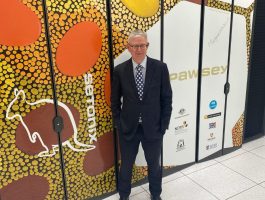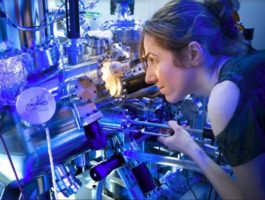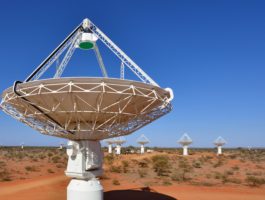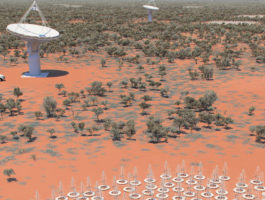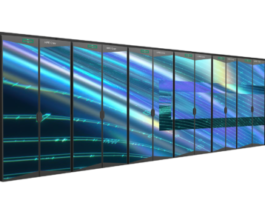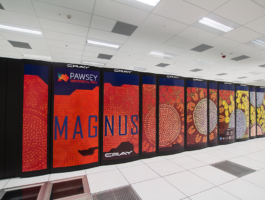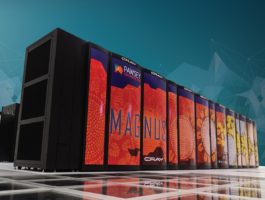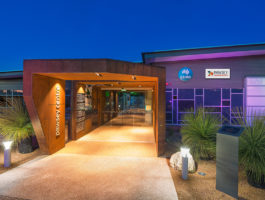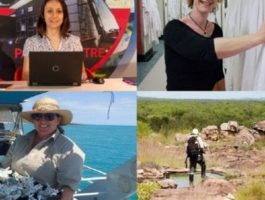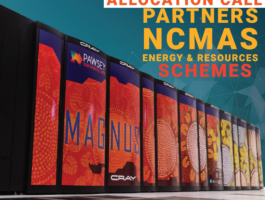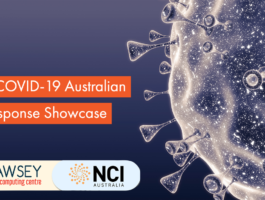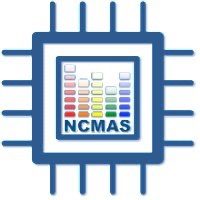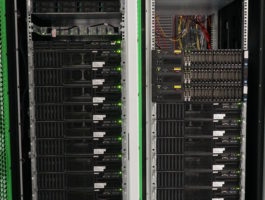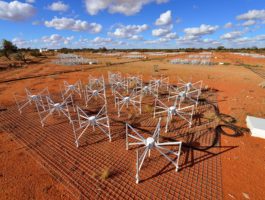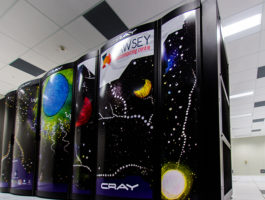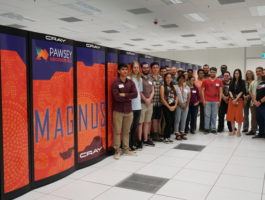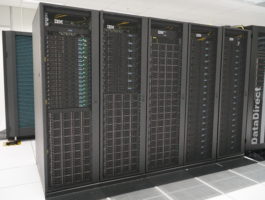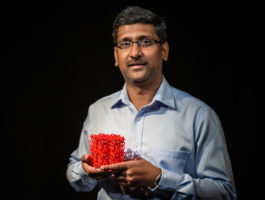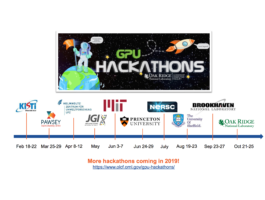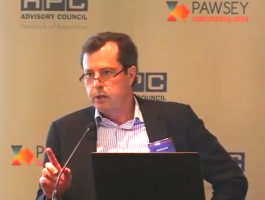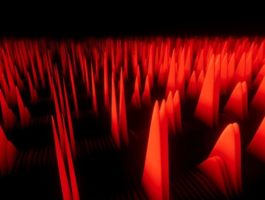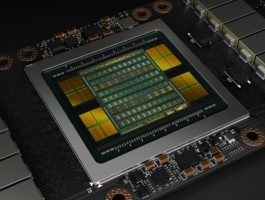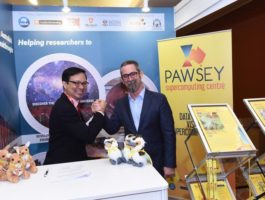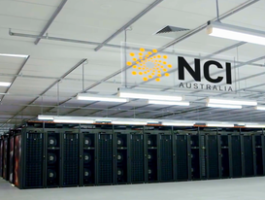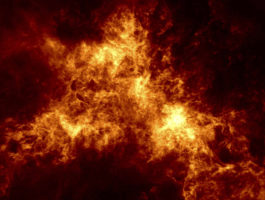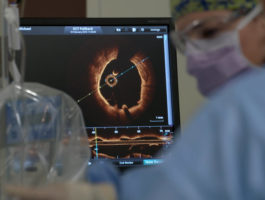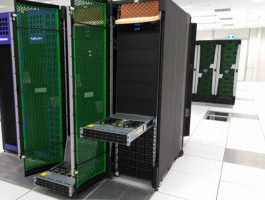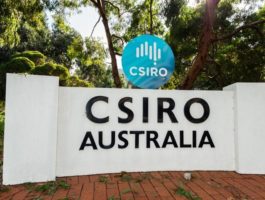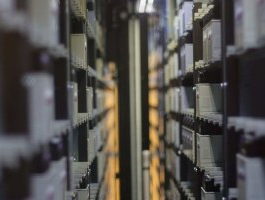Pawsey in the media
The Pawsey Supercomputing Centre are a Tier-1 facility in Australia which enables amazing, ground-breaking science across the nation. Due to this high profile, we have collected Pawsey coverage across a range of national and international media publications.AN AUSTRALIAN-MADE QUANTUM CHIP IN EVERY HOME? (PODCAST)
This week Quantum Brilliance announced a $26 million funding round, a significant boost to its lofty ambitions. Brent Balinski spoke to co-founder Dr Andrew Horsley about bringing Australian-made room-temperature quantum accelerators to the masses. Among people who care about such things, Intel’s examination of Australia as a possible home for a fabrication site in the
HPCwire Unveils Editors’ Superlative Awards
Each November, HPCwire’s readers and editors recognize dozens of individuals and organizations across more than 20 very serious award categories, celebrating technology innovations and HPC-driven research that will transform both the industry and the world. But throughout the year, while covering these developments, there are lots of nooks and crannies in the HPC community that go
Supercomputer Can Predict ICU Patient Dangers To Give Healthcare Workers a Warning
A patient in the intensive care unit (ICU) can deteriorate quickly. Doctors may have little to no warning before machines ping, panic sets in, and a patient faces irreparable damage or death from a brain bleed. Many times these crises have been impossible to predict. Data researchers have now combined efforts with the Pawsey Supercomputing Research
When it comes to jobs SKA’s the limit for kids in this remote Western Australian school
The challenges for the kids are immense, but they’re familiar with those out on the red soil sand dunes and spinifex country of mid west Western Australia. “In this little community where we are, there are no roads, no services, no shops,” says Susan Trigwell, the Principal of Pia Wadjarri Remote Community School. “There’s no swimming
SMP 2023 scholarships: open now
For Science Meets Parliament 2023, nine scholarship recipients will be able to access a full program of career-defining professional development training at no cost. Science Meets Parliament is Australia’s most significant event for deep engagement between the science and technology community and policymakers. Science & Technology Australia is offering the scholarships thanks to our generous sponsors: Exciton
Right place, right time for data centres
GEOGRAPHY is playing a major part in a growth industry that would otherwise likely bypass a relatively small and isolated economy like Western Australia’s. It is, perhaps, a convergence of needs, technological change, risk aversion, some decades-old policy decisions and the unusual demands of local industry that have made the state particularly attractive to those
Inspiring the future WA leaders of STEM
Year 12 students have toured world-class STEM facilities in Western Australia and networked with industry and education experts to gain a better understanding of the exciting STEM opportunities awaiting them right here in this State. It’s all part of the National Youth Science Forum’s (NYSF) flagship Year 12 program, which seeks to connect the State’s
Grant quantum leap for women in STEM
The University of Western Australia will help enhance female participation in modern quantum science through Quantum Girls, a Women in STEM and Entrepreneurship project. The Australian Government’s Department of Industry, Science, Energy and Resources announced funding of $879,000 to support the project. The project is designed to address a skills shortage and gender imbalance in
VIDEO: Decommission of the Pawsey Supercomputing Research Centre’s Magnus Supercomputer
Decommission of the Pawsey Supercomputing Research Centre’s Magnus Supercomputer. Magnus was a Petascale supercomputer that clocked over 2 billion hours of Australian research.
Perth Pawsey supercomputer predicts ICU patient outcomes before they worsen
From mapping the stars to predicting weather patterns, Perth’s Pawsey supercomputing centre has been used by the brightest minds to solve some of the most complex problems. Key points: An algorithm is being used to track patient data and predict brain bleeds About 40,000 hours of patient data has been used to create the algorithm It could give
How NVIDIA helped 3D researchers bring naval history to life
Museumgoers will be able to explore two sunken WWII ships as if they were scuba divers on the ocean floor, thanks to work at Curtin University in Perth, Australia. Exhibits in development, for display in Australia and potentially further afield, will use exquisitely detailed 3D models the researchers are creating to tell the story of
Pawsey gets ready for user workloads on Setonix
Scientists prepare for new architecture. The Pawsey Centre’s Setonix supercomputer is getting ready to onboard its first user communities, to be ready for full operations by February 2023. In an interview with iTnews, Pawsey’s executive director Mark Stickells said since Phase 1 of the project went live in June, the centre has finished removing the previous flagship,
HPE delivers the world’s fastest, energy-efficient supercomputers at SC22
The computers that we use today are powerful enough to handle complicated tasks. Despite their enormous potential, they still need to work on tackling demanding tasks that call for a lot of processing power, which is why supercomputers are made. Global innovation, industry competitiveness, and economic expansion all depend on supercomputing. At Supercomputing 2022 (SC22), the
Forrest backs tech to reveal ocean inhabitants from a bucket of water
The world’s oceans are troubled by plastic pollution, overfishing and a warming climate, but it is hard to save them if scientists know little of what lives there. When Dr Andrew Forrest spent hours counting fish filmed underwater for research towards a PhD, he thought there had to be a better way. Now, his Minderoo
White Spark Pictures announces ‘Beyond the Milky Way’ documentary series
White Spark Pictures’ Beyond the Milky Way, an immersive film about the construction of one of the world’s largest radio telescopes, is set to be expanded into a new decade-long documentary series. The World’s Largest Telescopes: Beyond the Milky Way will begin with two hour-long installments that examine the Square Kilometre Array (SKA) project in Western Australia’s
Hot ice cream, sleepless cats and affordable quantum computers
Some things are not impossible, but are, still, implausible – in the absence of creativity, consistency of efforts and bold thinking. Enterprise-easy quantum computing is one such oxymoron. Let’s find out why voodoo-factors and plateaus matter here Exactly a decade back, in 2012, the Nobel Prize in Physics went in the lap of Serge Haroche
Pawsey Supercomputing Research Centre’s Setonix ranks fourth on Green500 list
Pawsey Supercomputing Research Centre’s Setonix has been recognized as the world’s fourth greenest supercomputer on the Green500 list. Named after the native Quokka (Setonix brachyurus), known for being the ‘world’s happiest animal,’ the Setonix HPC has similarly made waves by being the most powerful supercomputer in the southern hemisphere, as well as one of the
Space-age Perth supercomputer keeps its cool to join ranks of world’s greenest
The most powerful computer in the southern hemisphere can now boast that it is also the greenest, with the Perth-based tech titan ranked among the top five global research computers for energy efficiency. Setonix – named after one of Western Australia’s most recognisable marsupials, the quokka (Setonix brachyurus) – will be available to researchers at
See a Sea Change: 3D Researchers Bring Naval History to Life
Museumgoers will be able to explore two sunken WWII ships as if they were scuba divers on the ocean floor, thanks to work at Curtin University in Perth, Australia. Exhibits in development, for display in Australia and potentially further afield, will use exquisitely detailed 3D models the researchers are creating to tell the story of
Quantum Brilliance takes out Manufacturing Innovation Award
Canberra-based Quantum Brilliance has won the Manufacturing Innovation category at the InnovationAus 2022 Awards for Excellence for its work to make quantum computing an accessible, everyday technology.
AMD Drives Leadership Performance and Energy Efficiency in Supercomputing
SANTA CLARA, Calif., Nov. 15, 2022 (GLOBE NEWSWIRE) — At the Supercomputing Conference 2022 (SC22), AMD (NASDAQ: AMD) showcased its continued momentum and dominating presence within the high performance computing (HPC) industry. AMD EPYC™ CPUs and AMD Instinct™ accelerators continue to be the processors of choice for the most demanding HPC workloads powering the most complex simulations
Pawsey gets funding commitment from WA gov
The Western Australian government will spend $22.4 million over five years supporting the Pawsey Supercomputing Research Centre, in return for access to its facilities. Those facilities include the country’s and southern hemisphere’s fastest HPC machine, Setonix, also recognised as one of the least-polluting supercomputers in the Green500 list. The 500-node, 65,000 core Setonix went live in July.
Australian supercomputer fourth greenest in world
Pawsey Supercomputing Research Centre announced its latest supercomputer, Setonix, has been recognised as one of the greenest supercomputers in the world, after ranking in the top5 on the globally recognised Green500 list. Announced today at the international supercomputing conference SC22 in Texas, the ranking puts Setonix in company with exascale supercomputers Frontier in the US
Pawsey to Receive $22M in Western Australia Government Funding
Nov. 15, 2022 — The Pawsey Supercomputing Research Centre has welcomed the news that it will receive more than $22.4 million in funding from the Western Australian Government over five years, to support the positioning of WA as an international leader in high-performance computing (HPC). The announcement was made hours after Setonix, Pawsey’s new supercomputer
WA supercomputer one of the world’s greenest and most powerful
Pawsey Supercomputing Research Centre’s newest supercomputer Setonix ranks fourth in globally recognised Green500 list Setonix named most powerful public research supercomputer in the Southern Hemisphere, ranking 15 in the global Top500 McGowan Government has boosted funding for the Pawsey Supercomputing Research Centre, committing $22.4 million over five years Western Australia is officially home to one
Magnetism or no magnetism? The influence of substrates on electronic interactions
A new study illustrates how substrates affect electronic interactions in 2D metal-organic frameworks. With electronic properties tuneable by electrical charge, mechanical strain, and hybridization, such structures can be ‘switched’ off and on, allowing potential applications in future energy-efficient electronics.
UNSW’s Evatt Hawkes is using new technology to decarbonise our world
Evatt Hawkes has turned his childhood pyromania to good account – investigating fire and combustion at an elevated level of science. Now a professor of mechanical engineering at the University of NSW, he uses computational modelling to further the global understanding of combustion in renewable energy technology.
MARTIAN ROCK WINDS BACK THE CLOCK
Almost 10 million years ago, a meteorite crashed into Earth. Hidden inside were 23 microscopic grains which tell the story of how Mars evolved. Using one of WA’s most powerful supercomputers, astronomers have now uncovered the meteorite’s life story.
New company planning 96MW data center site in Perth, Australia
A new data center company is planning a 96MW development in Perth, Australia. Design and planning firm Urbis Pty Ltd is applying to build an AU$600 million (US$379m) data center campus in the Belmont area of the city at 37 Abernethy Road. – GreenSquareDC The client in the application is listed as GreenSquareDC, which describes
Decoding Signals From Space
Asian Scientist Magazine (Oct. 10, 2022) — From hologram Princess Leia in the internationally beloved Star Wars franchise to Bubs the robot in the popular Korean movie Space Sweepers, which space-themed science fiction story would be complete without a matrix of futuristic tech? Aboard Starfleet vessels, an entire arsenal of computers—even artificial intelligence units—and handheld Personal
Diamond future for Canberra’s Quantum Brilliance
In 2019, some intellectual property created through a research project at the Australian National University was spun out as a startup which might change how we all use computers. The research focused on diamond quantum science, and Quantum Brilliance was born, created to commercialise the technology and to produce lunchbox-sized quantum accelerators using these synthetic diamonds.
National Quantum Advisory Committee
The Minister for Industry and Science, Ed Husic MP, has announced the National Quantum Advisory Committee that will help drive Australia’s National Quantum Strategy. The 15-person committee, chaired by Australia’s Chief Scientist Dr Cathy Foley AO, will be an integral part of the push to coordinate Australia’s quantum capability across research, industry and government. Minister Husic also said
Supercomputer produces a supernova
G261.9+5.5 has only been cursorily studied, and the previous best radio image of this SNR dates back to the late 1980s. That image — from the Australian MOST observatory — has a very low signal-to-noise ratio, and shows a barely discernible ring of emission with hints of substructure. The new ASKAP image shows 943.5 MHz
Source of ancient Martian rocks found using Perth supercomputer
Five to ten million years ago an asteroid smashed into Mars. It created a massive crater and propelled a chunk of ancient Martian crust into space as a new meteorite, which eventually crashed into Africa.
Source of ancient Martian rocks found using Perth supercomputer
Five to ten million years ago an asteroid smashed into Mars. It created a massive crater and propelled a chunk of ancient Martian crust into space as a new meteorite, which eventually crashed into Africa.
Australia’s newest Cray supercomputer is online in Perth
Australia’s newest supercomputer is already providing science with exciting new opportunities.
Promising beginnings for Australia’s newest supercomputer
Australia's newest supercomputer, Setonix, has produced a highly detailed image of a supernova remnant immediately after the computing system's first stage was made available to researchers.
Perth supercomputer images aftermath of star’s violent death in first big test
The Pawsey Supercomputing Centre, already a behemoth of scientific data processing, just put the first stage of its new supercomputer through a demanding “stress test” – and it gave a stellar performance.
Remnant of supernova blast captured in incredible image by Australian supercomputer
A huge explosion from a dying star has been captured in a spectacular image by an Australian radio telescope and supercomputer.
A new Australian supercomputer has already delivered a stunning supernova remnant pic
Within 24 hours of accessing the first stage of Australia’s newest supercomputing system, researchers have processed a series of radio telescope observations, including a highly detailed image of a supernova remnant.
New $70M Supercomputer Generates Highly Detailed Image of a Supernova
Australia’s newest supercomputer, Setonix, has created a highly-detailed image of a supernova remnant using an enormous amount of data collected by the ASKAP (Australian Square Kilometre Array Pathfinder) telescope
Pawsey’s Setonix Supercomputer Fires Up for Researchers
The first phase of the new Setonix supercomputer at the Pawsey Supercomputing Centre is now available, creating a faster, user-friendly interface to accelerate discoveries.
Pawsey launches first phase of Australia’s 50 petaflops Setonix system
The Pawsey Supercomputing Centre has launched the first phase of its new 50 petaflops Setonix supercomputer in Perth, Australia
Source of ancient Martian rocks found using Perth supercomputer
Five to ten million years ago an asteroid smashed into Mars. It created a massive crater and propelled a chunk of ancient Martian crust into space as a new meteorite, which eventually crashed into Africa.
Source of ancient Martian rocks found using Perth supercomputer
Now we can sample other planets without leaving home
Pawsey Supercomputing Centre installs room-temperature diamond-based quantum computer
The Pawsey Supercomputing Research Centre has installed a room-temperature diamond-based quantum computer developed by Quantum Brilliance.
Pawsey Installs First Room-Temp, On-Prem Quantum Computer in a Supercomputing Center
HAMBURG, Germany, ISC 2022, May 31, 2022 — Australia’s leading research supercomputing facility Pawsey Supercomputing Research Centre has today announced the installation of the world’s first room-temperature diamond-based quantum computer located on-site in a supercomputing facility.
PAWSEY CENTRE INSTALLS DIAMOND-BASED QUANTUM COMPUTER
Perth’s Pawsey Supercomputing Research Centre will trial a Quantum Brilliance room-temperature, diamond-based quantum ‘accelerator’ computer.
Quantum Brilliance installs world-first system at Pawsey
The world’s first diamond-based quantum accelerator has been installed at the Pawsey Supercomputing Research Centre in Western Australia after more than a year of development by German-Australian deep tech startup Quantum Brilliance.
First room-temperature quantum computer in supercomputing centre
The world’s first room-temperature diamond-based quantum computer, developed in Germany, has been installed on-site in a supercomputing facility in Australia. The installation at the Pawsey Supercomputing Research Centre uses a rack mounted quantum computer developed by German-Australian start-up Quantum Brilliance. This uses a synthetic diamond chip with nitrogen vacancies to provide the quantum processing.
Diamond-based quantum computer paired with supercomputers for first time
Quantum computing may have just taken a major step forward, as a supercomputer facility in Australia becomes the first to have a quantum computer integrated into it. The quantum processor, developed by German-Australian start-up Quantum Brilliance, runs at room temperature, and will now work in tandem with classical supercomputers at the Pawsey Supercomputing Research Centre.
Pawsey just added quantum to a supercomputer
The Pawsey Supercomputing Centre has added small quantum processor to its $48 million Setonix supercomputer in order to test the limits of room-temperature quantum computing.
Australian Quantum Computing is Heating Up With Pawsey’s Room-Temperature Accelerator
It’s cold outside, but not at the Pawsey Supercomputing Research Centre in Perth. In fact, it’s a nice room-temperature there. Which is insane, because it’s housing a quantum computer.
Tail of the sky serpent has been captured in wonderful new telescope image
New year, new awe-inspiring image of the cosmos. For example, the infrared James Webb Space Telescope started taking full colour images in July last year, and this year is likely to be even more exciting. The telescope will be able to examine every phase of cosmic history, from the first luminous glows after the Big
Australia’s opportunity to become a clean data superpower
When data was described as the new oil, those who coined the phrase probably weren’t thinking about emissions. Yet, as well as both being valuable commodities, they share a less pleasant trait; they can drive up emissions.
TRENDING NOW: NVIDIA GeForce RTX 4090 leaks: beast GPU, 100%+ faster than RTX 3090 Super Computing Australia’s new 50 petaflop supercomputer: 200,000+ AMD EPYC CPU cores
Pawsey Supercomputing's next-gen Setonix supercomputer uses AMD Milan CPUs and Mi-Next GPUs, packs 50 petaflops of power. Read more: https://www.tweaktown.com/news/80404/australias-new-50-petaflop-supercomputer-200-000-amd-epyc-cpu-cores/index.html
Pawsey Prepares for the Data Deluge from the Square Kilometre Array
As the largest-ever radio telescope, the Square Kilometre Array (SKA) will be a behemoth
“There is significant opportunity”: SMEs gain access to cutting edge space data facility and training in Western Australia
Small businesses seeking satellite data to drive innovation now have access to the latest geospatial data sets from the Australian Space Data Analysis Facility which launched this week in Western Australia.
Black swan DNA could help us understand human response to bird flu
In a world-first, scientists from The University of Western Australia have assembled the entire DNA of the black swan, which could offer insight into how the bird, and even humans, respond to bird flu and other pandemics in the same family of viruses.
Australian gov to spend $64m on Pawsey Square Kilometre Array supercomputer
The Australian government will spend $64.4 million on a new supercomputer in Perth to process and analyze data from the Square Kilometre Array (SKA) radio telescope.
Quantum Brilliance and Quantum-South Partner on Logistics Optimisation
Quantum Brilliance and Quantum-South today announced a partnership to jointly develop and market complementary products and technology in shipping logistics optimization. The companies will be performing proof-of-concept implementations with air and marine cargo companies to showcase the potential of quantum computing to solve highly complex logistics problems beyond the scope of today’s classical computers. The two firms are also working with the Pawsey Supercomputing Centre and the Quantum Supercomputing Innovation Hub to demonstrate quantum utility through co-development projects with Australian companies as part of the Quantum Pioneer Program.
Australian Government Invests $50M for SKA Telescope Project Supported by Pawsey Supercomputing
The Australian federal government will invest $50 million to establish a centre in Perth to process and analyse data from the Square Kilometre Array (SKA) radio telescope.
SKA telescope gets $387m shot in the arm
The Prime Minister Scott Morrison has committed a further $387 million to the massive Square Kilometre Array radio telescope in Western Australia’s Murchison region, including $64 million that will underwrite a new supercomputing centre.
Australian gov to spend $64m on Pawsey Square Kilometre Array supercomputer
The Australian government will spend $64.4 million on a new supercomputer in Perth to process and analyze data from the Square Kilometre Array (SKA) radio telescope.
$64.4 million for WA to process signals from the dawn of time
The federal government will invest $64.4 million to establish a centre in Perth to process and analyse data from the Square Kilometre Array (SKA) radio telescope.
Laser to zap space debris, funding for SKA
ANU team helps build a laser to move space debris; PM announces funding boost for astronomy.
Govt allocates $64m over 10 years for Pawsey supercomputing
The federal government has earmarked $64.3 million for the Pawsey Supercomputing Centre in Perth for a data processing facility for the Square Kilometre Array (SKA) radio telescope.
Diamond-Based Quantum Accelerator Puts Qubits in a Server Rack
A quantum computer the size of a PC graphics card? One Australian-German startup says they’re working a technology that may deliver just that within five years.
Quantum leap in technology for physics students at ANU – About Regional
Even if you don’t understand quantum computing, a business start-up of students from the Australian National University’s physics department is turning up the heat on the technology that uses synthetic diamonds so the computer can operate at room temperature.
Synthetic Diamond Technology Could Make Quantum Practical
Quantum Brilliance will install a diamond-based quantum accelerator at the Pawsey Supercomputing Centre. Leveraging synthetic diamond technology, Quantum Brilliance is an Australian start-up supported by the Australian National University
Diamond-Based Quantum Accelerator Might Make Quantum Practical
Quantum Brilliance will install a diamond-based quantum accelerator at the Pawsey Supercomputing Centre. Leveraging synthetic diamond technology, Quantum Brilliance is an Australian start-up supported by the Australian National University.
Quantum Brilliance gets a Pawsey step-up
Quantum Brilliance, the Australian-German deep tech startup spun-out of the Australian National University, will deliver a world first diamond quantum accelerator to the Pawsey supercomputing research facility in Perth.
World’s First Market-Ready Diamond-based Quantum Accelerator Coming to Pawsey Supercomputing Centre
Quantum Brilliance, a venture-backed Australian quantum computing startup from The Australian National University, will install the world’s first diamond quantum accelerator at the Pawsey Supercomputing Centre.
HPE enhances portfolio of computing solutions using AMD EPYC 7003 series processor
Hewlett Packard Enterprise announced record-breaking performance on a wide range of demanding workloads, surpassing competitors by up to 39%1 with its new computing solutions as part of the industry’s broadest set of AMD EPYC processor-based offerings.
Hewlett Packard Enterprise Unveils Industry’s Broadest Portfolio of AMD EPYC™ Processor-Based Solutions to Power the Edge to Exascale
HPE’s enhanced portfolio of computing solutions using the new AMD EPYC™ 7003 Series Processor break world records with up to 39% better performance and greater energy efficiency to target any workload
Hewlett Packard Enterprise Unveils Portfolio of AMD EPYC Processor-based Solutions
Hewlett Packard Enterprise today announced record-breaking performance on a wide range of demanding workloads, surpassing competitors by up to 39% with its new computing solutions as part of the industry’s broadest set of AMD EPYC processor-based offerings.
Pawsey supercomputer set to integrate diamond quantum accelerator
Perth’s Pawsey Supercomputing Centre is set to become one of the first supercomputing centres globally to host a quantum computer onsite.
The History of Supercomputing vs. COVID-19
The COVID-19 pandemic poses a greater challenge to the high-performance computing community than any before. HPCwire‘s coverage of the supercomputing response to the pandemic began in early February 2020 and has since encompassed hundreds of articles
Ungaro Departs: New HPC Leadership at HPE and Dell as Companies Vie for Server Top Spot
HPE and Dell, engaged in a neck-and-neck struggle for superiority in HPC servers, also are engaged in a reshuffling of their HPC leadership teams that may reflect similar visions of HPC’s evolving position across IT.
SupercomputingAsia 2021 highlights cooperation as key in addressing future global challenges
Singapore: An MOU that was signed between Singapore entities and Finland’s CSC at the SCA21 conference is a reflection of the ongoing collaborative spirit in the HPC community. The MOU was announced by Dr Vivian Balakrishnan, Minister for Foreign Affairs and Minister-in-Charge of the Smart Nation Initiative at the Opening Ceremony of the SCA21 virtual conference, which adopted the theme ‘Supercomputing in the New Norm – Adapting to COVID-19 and beyond’.
Pawsey Centre names new supercomputer after quokka
The Pawsey Supercomputing Centre has announced that its new system will be named Setonix — the scientific name for the quokka. The HPE Cray EX supercomputer will be 30 times more powerful than Pawsey’s existing systems, Magnus and Galaxy, and will be used to help accelerate research projects such as the Square Kilometre Array.
Pawsey Supercomputer Centre to name new supercomputer ‘Setonix’, after quokka
Australia’s fastest new research supercomputer will be named after WA’s humble quokka. The Pawsey Supercomputer Centre, a government-supported national high-performance computing facility based in Kensington, said it will name its new system ‘Setonix’ after the scientific name for the quokka, Setonix brachyurus. The HPE Cray EX supercomputer will be much faster than Pawsey’s existing systems, Magnus and Galaxy.
Pawsey Reveals Name of Australia’s Fastest Research Supercomputer
A cheerful marsupial will lend its name to Australia’s fastest new research supercomputer, with Pawsey Centre confirming its new system will be named Setonix – the scientific name for the quokka, dubbed the world’s friendliest animal. The HPE Cray EX supercomputer will be 30 times more powerful than Pawsey’s existing systems, Magnus and Galaxy, and will be used to help accelerate research projects such as the Square Kilometre Array.
Pawsey unveils its super-fast tribute to quokka
The world’s friendliest animal will lend its name to Australia’s fastest new research supercomputer, with the Pawsey Centre confirming its new system will be named Setonix – the scientific name for the quokka. The HPE Cray EX supercomputer will be 30 times more powerful than Pawsey’s existing systems, Magnus and Galaxy, and will be used to help accelerate research projects such as the Square Kilometre Array.
Harnessing socially-distant molecular interactions for future computing
Could long-distance interactions between individual molecules forge a new way to compute? Interactions between individual molecules on a metal surface extend for surprisingly large distances - up to several nanometers. A new study, just published, of the changing shape of electronic states induced by these interactions, has potential future application in the use of molecules as individually addressable units.
In blink of an eye astronomers win prestigious American science prize
A team of scientists led by CSIRO astronomer Dr Keith Bannister has been awarded the 2020 AAAS Newcomb Cleveland Prize for the best science paper of the year by the prestigious publication, Science. The international team of 54 astronomers were the first to pinpoint the location of a fast radio burst. Fast radio bursts (FRB) are intense pulses of radio emission that last only a fraction of a second and had confounded astronomers for more than a decade.
AMD TAKES DOWN ANOTHER SUPERCOMPUTER DEAL IN EUROPE
The Dutch national supercomputer, called “Cartesius,” which is used for HPC education and research, is getting rather long in the tooth with some of its components being installed as far back as 2013. So the government of the Netherlands and the SURF supercomputing center are shelling out €20 million to build a new and as yet unnamed system at the SURF facility in the Amsterdam Data Tower (shown in the feature image) in the Dutch capital. Among architectural details, which we always find interesting, the deal to build this new system is interesting because Bull/Atos, the incumbent system supplier and clearly on the rise in the HPC sector in Europe, lost out to Lenovo, the heir to IBM’s former HPC business in Europe.
Student astronomer finds galactic missing matter
Astronomers have for the first time used distant galaxies as 'scintillating pins' to locate and identify a piece of the Milky Way's missing matter. For decades, scientists have been puzzled as to why they couldn't account for all the matter in the universe as predicted by theory. While most of the universe's mass is thought to be mysterious dark matter and dark energy, 5 percent is 'normal matter' that makes up stars, planets, asteroids, peanut butter and butterflies. This is known as baryonic matter.
W zaledwie 10 dni odkryto milion nowych galaktyk
W 300 godzin przeprowadzono astronomiczne badanie nieba, które niedawno zajmowało lata. Efektem ekspresowego mapowania nieba południowego przez naukowców pracujących na radioteleskopie ASKAP w Australii są trzy miliony zidentyfikowanych galaktyk, z czego milion dotąd nieznanych.
A new 3D koala genome will aid efforts to defend the threatened species
Koalas are unique in the animal kingdom, living on a eucalyptus diet that would kill other creatures and drinking so little their name comes from the Dharug word gula, meaning “no water”. Today, many koala populations across Australia are in decline, due to habitat destruction caused by agriculture, urbanisation, droughts and bushfires intensified by climate change, and diseases such as chlamydia and koala retrovirus.
Nano-Thin Piezoelectrics Advance Self-Powered Electronics
A new type of ultra-efficient, nano-thin material could advance self-powered electronics, wearable technologies and even deliver pacemakers powered by heart beats. The flexible and printable piezoelectric material, which can convert mechanical pressure into electrical energy, has been developed by an Australian research team led by RMIT University.
Nano-thin piezoelectrics advance self-powered electronics
A new type of ultra-efficient, nano-thin material could advance self-powered electronics, wearable technologies and even deliver pacemakers powered by heart beats. The flexible and printable piezoelectric material, which can convert mechanical pressure into electrical energy, has been developed by an Australian research team led by RMIT University.
Mapa do Universo é gerado em menos de 300 horas
Em 2009, o povo Wajarri Yamatji e a Organização de Pesquisa Científica e Industrial da Commonwealth (CSIRO) fizeram um acordo para levantar, em terras aborígenes, o Australian Square Kilometer Array Pathfinder (ASKAP), o conjunto de 36 radiotelescópios que vasculham o cosmos dia e noite. A parceria tem dado frutos ao longo dos anos, mas nada como o que foi anunciado agora: um mapa de todo o Universo concluído em menos de 15 dias.
Australian telescope creates a new atlas of the Universe
The Australian Square Kilometre Array Pathfinder (ASKAP), developed and operated by Australia’s national science agency, CSIRO, mapped approximately three million galaxies in just 300 hours. The Rapid ASKAP Continuum Survey is like a Google map of the Universe where most of the millions of star-like points on the map are distant galaxies – about a million of which we’ve never seen before.
Astronomers map a million previously undiscovered galaxies in record time
02 December 2020NewsAstronomers map a million previously undiscovered galaxies in record time ASKAP's atlas of the southern sky, collected at record speed in just 300 hours. Image: CSIRO ASKAP's atlas of the southern sky, collected at record speed in just 300 hours. Image: CSIRO by Kerry Hebden In a feat which normally takes years to complete, the Australian Square Kilometre Array Pathfinder (ASKAP), developed and operated by Australia's national science agency, CSIRO, has mapped approximately three million galaxies in just 300 hours. The study, dubbed the Rapid ASKAP Continuum Survey (RACS), surveyed 83 percent of the sky in record-breaking time to produce the most detailed survey of the southern sky ever carried out using radio waves.
3 milioni di galassie mappate in 300 ore grazie a rete di radiotelescopi australiana
Circa 3 milioni di galassie mappate in 300 ore: è questo l’obiettivo raggiunto dagli astronomi grazie all’Australian Square Kilometre Array Pathfinder (ASKAP), una rete di 36 radiotelescopi, ognuno con un’antenna parabolica di 12 metri di diametro, situati nelle Midwest australiano entrati in funzione per la prima volta nel 2012.
Research gets closer to making nuclear fusion power a reality
A new study published in the Atomic Data and Nuclear Data Tables journal claims to have taken a major step towards making nuclear fusion power a reality. In the study, lead researcher and PhD candidate at Australia’s Curtin University, Liam Scarlett, presents a database of electron-molecule reactions that will allow other scientists to accurately model plasmas containing molecular hydrogen.
Pawsey’s Galaxy Supercomputer Aids Telescope in Creating New Atlas of the Universe
The Australian Square Kilometre Array Pathfinder (ASKAP), developed and operated by Australia’s national science agency, CSIRO, mapped approximately three million galaxies in just 300 hours. The Rapid ASKAP Continuum Survey is like a Google map of the universe where most of the millions of star-like points on the map are distant galaxies—about a million of which we’ve never seen before.
Un atlas del Universo trazado en solo 300 horas
El Australian Square Kilometer Array Pathfinder (ASKAP) de la agencia científica nacional de Australia, CSIRO, ha trazado un atlas del Universo con tres millones de galaxias en solo 300 horas.
L’atlante cosmico di Askap
Tre milioni di galassie in trecento ore. Il precursore australiano di Ska ha completato la sua prima survey dell’intero cielo meridionale con velocità e dettagli record, creando un nuovo atlante dell’universo. Il supercomputer Galaxy del Pawsey Supercomputing Centre ha convertito i dati in immagini radio 2D da 70 miliardi di pixel
Collision models impact the future of energy
A new database of electron-molecule reactions is a major step forward in making nuclear fusion power a reality, by allowing researchers to accurately model plasmas containing molecular hydrogen.
Australian SKA Pathfinder maps 3 million galaxies at lightning speed
It took just 300 hours to survey the entire southern sky to create a new atlas of the Universe. The Australian Square Kilometre Array Pathfinder (ASKAP) has completed its first survey of the entire southern sky, creating what the Commonwealth Scientific and Industrial Research Organisation (CSIRO) has labelled as a new atlas of the Universe. The ASKAP mapped approximately 3 million galaxies in just 300 hours. The 13.5 exabytes of raw data generated by ASKAP was processed using hardware and software custom-built by CSIRO.
CSIRO telescope creates ‘atlas of the universe’
Parses 13.5 exabytes of data on Pawsey supercomputer. A new CSIRO telescope mapped out the sky in just three weeks, building a new foundation for the future of radio astronomy. The Australian Square Kilometre Array Pathfinder (ASKAP) started its first full survey of the celestial sphere in April last year. Its large team of scientist have just published the first results in the Publications of the Astronomical Society of Australia.
AMD EPYC Processors and New AMD Instinct MI100 Accelerator Redefine Performance for HPC
During this year’s SC20 virtual tradeshow, AMD is showcasing its leadership in the high performance computing (HPC) industry. It launched the new AMD Instinct MI100 accelerator with ROCm 4.0 open ecosystem support and showcased a growing list of AMD EPYC CPU and AMD Instinct accelerator based deployments
Supercomputer to speed up genomic sequencing
AGRICULTURAL researchers will be among the beneficiaries of an upgrade at the Pawsey Supercomputing Centre in Perth. Pawsey recently announced the purchase of a new supercomputer, in the centre's biggest upgrade since opening in 2009, funded by a government grant. The new supercomputer will deliver up to 50 petaFLOPs, or 30 times more compute power than its predecessor.
Supercomputer to speed up genomic sequencing
AGRICULTURAL researchers will be among the beneficiaries of an upgrade at the Pawsey Supercomputing Centre in Perth. The centre is a joint venture between CSIRO, Curtin University, Edith Cowan University, Murdoch University and The University of Western Australia, supported by the Western Australian and Federal Governments. Pawsey recently announced the purchase of a new supercomputer, in the centre's biggest upgrade since opening in 2009, funded by a government grant.
HPE TO BUILD NEW PAWSEY SUPERCOMPUTER AT PAWSEY SUPERCOMPUTING CENTER
Last month, Pawsey Supercomputing Center selected Hewlett Packard Enterprise (HPE) to deliver its new supercomputer as part of the biggest upgrade to the Pawsey computing infrastructure, which opened in 2009. As a result, HPE was awarded AU$48 million contract for the same, following a thorough tender process led by Australia’s national science agency, CSIRO (Commonwealth Scientific and Industrial Research Organization), the center agent for Pawsey, based on energy efficiency, cost, and HPE’s integrated hardware and software solution.
HPE to build new Pawsey supercomputers
Hewlett-Packard Enterprise (HPE) has been awarded a A$48m contract to build a supercomputer for Pawsey Supercomputing Centre, one of Australia’s national supercomputing centres located in Western Australia. The supercomputer is part of a A$70m programme funded by the Australian government to invest in next-generation supercomputing to advance the nation’s research.
Podcast #69: Pawsey Supercomputing Centre
The HPC world is always one that’s a little amorphous to me. The workloads and analysis the scientists and researchers use are dramatically different than the garden variety applications we see in the enterprise. As such, these large Supercomputer sites operate differently in a number of ways. this podcast, I talk with a pair of Mark’s (Science Mark and Business Mark) from the Pawsey Supercomputing Centre in Western Australia. They’re making a $70 AUD million (~$50 USD million) investment to bring to life the next generation of their center. The bulk of those funds will go toward the yet-to-be-named Supercomputer itself, an HPE Cray EX powered by more than 200,000 AMD EPYC CPUs. Once complete, this will be Australia’s largest Supercomputer.
Hewlett Packard Enterprise will build a $160 million supercomputer in Finland
Hewlett Packard Enterprise (HPE) today announced it has been awarded over $160 million to build a supercomputer called LUMI in Finland. LUMI will be funded by the European Joint Undertaking EuroHPC, a joint supercomputing collaboration between national governments and the European Union. The supercomputer will have a theoretical peak performance of more than 550 petaflops and is expected to best the RIKEN Center for Computational Science’s top-performing Fugaku petascale computer, which reached 415.5 petaflops in June 2020.
CORRECTING and REPLACING Hewlett Packard Enterprise Selected to Build Australia’s Most Powerful Supercomputer for Advancing Scientific Research at Pawsey Supercomputing Centre
Pawsey will gain 30X more compute power and 10X more energy efficiency with advanced supercomputing solutions using the HPE Cray EX supercomputer featuring future AMD EPYC™ CPUs and AMD Instinct™ GPUs In the first paragraph of release, $ amounts should be in AUD. The updated release reads: HEWLETT PACKARD ENTERPRISE SELECTED TO BUILD AUSTRALIA’S MOST POWERFUL SUPERCOMPUTER FOR ADVANCING SCIENTIFIC RESEARCH AT PAWSEY SUPERCOMPUTING CENTRE
Pawsey kicks off new HPC program to scale up research sector
Preparing users for new $48m machine. The Pawsey Supercomputing Centre is creating a training and support program to help researchers take full advantage of a $48 million supercomputer due to come online in 2022. The Pawsey Centre for Extreme scale Readiness (PaCER) program targets “grand challenges,” or scientific problems that would not be able to be processed on its current Magnus and Galaxy supercomputers, which will be superseded by the as-yet-unnamed new machine.
Pawsey Launches New Partnering Program, to Achieve HPC Research at Scale
The Pawsey Supercomputing Centre has opened a call for submissions for a new program that will provide training and support for Australia’s research community, to prepare researchers for the next era of supercomputing and help them to deliver outcomes that benefit the nation. Pawsey Centre for Extreme scale Readiness (PaCER) program will enable researchers to take full advantage of its new HPE Cray 50PFlops supercomputer, which will be 30 times faster than its current systems – Magnus and Galaxy – and is expected to be fully commissioned by 2022
Women in HPC (WHPC) Forms New Australasian Chapter
Oct. 23, 2020 — An Australasian Chapter of the global organisation Women in High Performance Computing (WHPC) is aiming to better support diversity within and across the Australian and New Zealand HPC and eResearch sectors. The initiative, a collaboration between Monash University, Australasian eResearch Organisations (AeRO), NCI Australia, Pawsey Supercomputing Centre, and New Zealand eScience Infrastructure, was announced at the eResearch Australasia (eResAU) Conference 2020. “I’m thrilled to be announcing the Australasian Chapter of Women in HPC and the formalisation of what was already a growing community,” says Sam Moskwa, AeRO CEO. “It is not a group just for women but also allies and we want to be inclusive of diversity beyond gender.”
Minister hails Pawsey supercomputer advance
Science Minister Dave Kelly welcomes Pawsey Supercomputing Centre’s decision on new supercomputer provider System will be 30 times more powerful than previous systems New supercomputer will allow WA to play bigger role in globe-shaping research projects Science Minister Dave Kelly has welcomed Pawsey Supercomputing Centre’s milestone to award the contract for its new supercomputer.
HPE to build Pawsey’s new $48m supercomputer
The Pawsey Supercomputing Centre has selected Hewlett Packard Enterprise (HPE) to deliver its new supercomputer, which will be at least 10 times more power efficient than its predecessors Magnus and Galaxy. Pawsey’s new supercomputer will be built using the HPE Cray EX supercomputer and will feature expanded data storage, a 30-fold increase in computing power and future-generation AMD EPYC™ CPUs and AMD Instinct™ GPUs.
HPE to power new Pawsey supercomputer for Australian research
The Pawsey Supercomputing Centre has selected Hewlett Packard Enterprise (HPE) to deliver its new supercomputer, which will power future high-impact Australian research projects. HPE was selected as the preferred vendor under a $48 million agreement following a thorough tender process led by Australia’s national science agency, CSIRO, the centre agent for Pawsey, based on energy efficiency, cost, and HPE’s integrated hardware and software solution. Director of the Pawsey Supercomputing Centre, Mark Stickells, said the new system will help propel the position of Australian research on the global stage.
HPE Cray EX to give Pawsey a 30x compute boost
The Pawsey Supercomputing Centre has selected Hewlett Packard Enterprise (HPE) to deliver its new supercomputer, as part of the biggest upgrade to the Pawsey computing infrastructure since the centre opened in 2009. The new supercomputer will be at least 10 times more power efficient than its predecessors, Magnus and Galaxy, while providing a 30-fold increase in raw computer power.
In Australia, HPE to build supercomputer for scientific research
Hewlett Packard Enterprise (HPE) will be able to build a new supercomputer for the Pawsey Supercomputing Center in the Australian city of Perth. The contract value of this computational giant is $ 48 million (some 40.6 million euros). This supercomputer is part of the Pawsey Capital Refresh Program.
Market cap of Hewlett Packard Enterprise Company [HPE] reaches 12.52B – now what?
Hewlett Packard Enterprise Company [NYSE: HPE] price plunged by -0.11 percent to reach at -$0.01. The company report on October 19, 2020 that CORRECTING and REPLACING Hewlett Packard Enterprise Selected to Build Australia’s Most Powerful Supercomputer for Advancing Scientific Research at Pawsey Supercomputing Centre. Pawsey will gain 30X more compute power and 10X more energy efficiency with advanced supercomputing solutions using the HPE Cray EX supercomputer featuring future AMD EPYC™ CPUs and AMD Instinct™ GPUs .
HPE to build Pawsey’s newest supercomputer
The Pawsey Supercomputing Centre has selected Hewlett Packard Enterprise (HPE) to deliver its new supercomputer as part of the biggest upgrade to the Pawsey computing infrastructure since the centre opened in 2009. The new supercomputer will deliver up to 50 petaFLOPs, or 30 times more compute power than its predecessor systems Magnus and Galaxy, to help power the future high-impact Australian research projects.
HPE to Build Australia’s Most Powerful Supercomputer for Pawsey
The Pawsey Supercomputing Centre in Perth, Western Australia, has had a busy year. Pawsey typically spends much of its time looking to the stars, working with a variety of observatories and astronomers – but when COVID-19 hit, Earth demanded more of its attention. Even during a hectic time, Pawsey managed to net four nominations in the HPCwire Readers’ Choice Awards, including one for its work on COVID-19. Now, Pawsey is receiving a major upgrade to its supercomputing capabilities: a $33.8 million system provided by HPE that will stand as the most powerful system in Australia.
New supercomputer for Pawsey Centre
The Pawsey Supercomputing Centre has announced its biggest ever upgrade – an HPE supercomputer capable of performing at up to 50 petaFLOPs, which is 30 times the compute power of Pawsey's Magnus and Galaxy systems. The new supercomputer will be based on the HPE Cray EX architecture, with AMD Epyc CPUs and AMD Instinct GPUs. The upgrade also includes an expanded Cray Clusterstor E1000 storage system. It will be delivered in two stages. Phase 1, to be completed by Q3 2021, will provide a 45% increase in raw compute power compared with the Magnus and Galaxy systems, yet it will be just one-fifth of the size. Phase 2 should be completed by Q2 2022.
Pawsey to build new $48m supercomputer
Massive upgrade to the WA research centre. The Pawsey Supercomputing Centre is building a new $48 million supercomputer system in a bid to become a world leader of research computing. Drawing its 50 petaFLOPS from over 200,000 CPU cores, the new Hewlett Packard Enterprise (HPE) Cray EX is a massive upgrade over Pawsey’s existing Magnus
Hewlett Packard Enterprise Company (HPE) is set for a tempting yields with an average volume of 10.44M
Let’s start up with the current stock price of Hewlett Packard Enterprise Company (HPE), which is $9.56 to be very precise. The Stock rose vividly during the last session to $10.03 after opening rate of $9.96 while the lowest price it went was recorded $9.46 before closing at $9.48. Recently in News on October 19, 2020, CORRECTING and REPLACING Hewlett Packard Enterprise Selected to Build Australia’s Most Powerful Supercomputer for Advancing Scientific Research at Pawsey Supercomputing Centre. Pawsey will gain 30X more compute power and 10X more energy efficiency with advanced supercomputing solutions using the HPE Cray EX supercomputer featuring future AMD EPYC™ CPUs and AMD Instinct™ GPUs . You can read further details here
HPE builds supercomputer in Australia for scientific research
(HPE) has been selected to build a new supercomputer for Pawsey Supercomputing Center, one of Western Australia's largest and most innovative national supercomputing centers. The new supercomputer has a contract value of $ 48 million and is part of the Pawsey Capital Refresh Program. This program, funded by the Australian government, has $ 70 million to boost scientific research in the country through investments in supercomputers.
$48m for Perth supercomputer
The Pawsey Supercomputing Centre has signed a $48 million contract with Hewlett Packard Enterprise to deliver the biggest upgrade to its computing infrastructure since the centre opened in 2009.
HPE to build CSIRO $48M supercomputer
Hewlett Packard Enterprise (HPE) has won a $48 million project with research agency CSIRO to build a new supercomputer at Pawsey Supercomputing Centre in Western Australia. The integrated hardware and software solution features the new Cray EX system that promises to be 30x as fast as two of the centre's existing supercomputers (Magnus and Galaxy).
CORRECTING and REPLACING Hewlett Packard Enterprise Selected to Build Australia’s Most Powerful Supercomputer for Advancing Scientific Research at Pawsey Supercomputing Centre
Pawsey will gain 30X more compute power and 10X more energy efficiency with advanced supercomputing solutions using the HPE Cray EX supercomputer featuring future AMD EPYC™ CPUs and AMD Instinct™ GPUs CORRECTION...by Hewlett Packard Enterprise October 19, 2020 10:45 AM Eastern Daylight Time SAN JOSE, Calif.--(BUSINESS WIRE)--In the first paragraph of release, $ amounts should be in AUD.
HPE to deliver Pawsey’s new AU$48m research supercomputer
The Pawsey Supercomputing Centre in Western Australia will be receiving a new supercomputer thanks to a AU$48 million contract signed with Hewlett Packard Enterprise (HPE). The new supercomputer will deliver up to 30 times more compute power -- 50 petaflops -- than its predecessor systems Magnus and Galaxy.
HPE inks $48M contract for Australia’s supercomputing center
Hewlett Packard Enterprise (NYSE:HPE) awarded a A$48M contract to build a new supercomputer for Pawsey Supercomputing Centre, Australia’s supercomputing center located in Western Australia. The new supercomputer is part of the Pawsey Capital Refresh Program, which is a $70M program funded by the Australian government to invest in next-generation supercomputing to advance the nation’s research.
HPE to build Australia’s No. 1 Supercomputer at Pawsey Supercomputing Centre
Hewlett Packard Enterprise (HPE) today announced it was awarded a $48 AUD million contract to build a new supercomputer for Pawsey Supercomputing Centre, one of Australia’s leading national supercomputing centers, located in Western Australia. The new supercomputer is part of the Pawsey Capital Refresh Program, which is a $70 AUD million program funded by the Australian government to invest in next-generation supercomputing to advance the nation’s research.
HPE to build 50 petaflops Pawsey supercomputer for AU$48m
HPE has been awarded an AU$48m (US$34m) contract to build a 50 petaflops supercomputer for the Pawsey Supercomputing Centre. The HPE Cray EX system will be Australia’s most powerful supercomputer, when it fully launches in Q2 2022. Before then, two racks will be brought online by Q3 2021.
HPE to build Australia’s No. 1 Supercomputer at Pawsey Supercomputing Centre
Hewlett Packard Enterprise (HPE) today announced it was awarded a $48 AUD million contract to build a new supercomputer for Pawsey Supercomputing Centre, one of Australia’s leading national supercomputing centers, located in Western Australia. The new supercomputer is part of the Pawsey Capital Refresh Program, which is a $70 AUD million program funded by the Australian government to
AMD scores 200,000 cores worth of secret silicon at new Australian supercomputer
Australia’s Pawsey Supercomputing Centre has bet on unannounced AMD Epyc silicon to power a new 50-petaFLOP supercomputer. The centre refused to reveal clock speeds or other details of the silicon to us but did say that it will comprise over 1,600 dual-socket nodes and utilise over 200,000 cores. Those figures yield a per-machine core count of 125. We're willing to round that up to 128 and suggest that the centre is betting on the forthcoming Milan edition of AMD’s Epyc processors, which is widely expected to debut late in 2020. Today's Rome generation already reaches 64 cores per CPU, so if Milan goes there, too, it won’t be a surprise.
HPE AND AMD BAG THE BIG SUPERCOMPUTER DEAL DOWN UNDER
Speaking very generally, investment in capability-class supercomputers by national governments tends to scale with gross domestic product. The bigger the particular national economy, the bigger the investment in flops. And so when it comes to Australia, with the highest median wealth per citizen in the world – it jockeys with Switzerland in recent years on that metric – and a GDP of $1.89 trillion in Australian dollars in 2019 – $1.32 trillion in US dollars at exchange rates prevailing as 2019 came to a close – not only do we expect for the country to invest heavily in supercomputers. The people and businesses of Australia expect its governments to do so.
Harvesting data from large radio telescope arrays
Mark Stickells, executive director at Pawsey Supercomputing Centre, highlights the work done in Australia to deliver supercomputing facilities and the resources needed From its inception, the Pawsey facility has been dedicated to providing supercomputing to Australian scientists and researchers. The facility is also positioned as a major hub for radio astronomy.
Massive Hunt for Extraterrestrial Life Completed: What Astronomers Found in Search of 10 Million Star Systems for Alien Technology
A radio telescope in outback Western Australia has completed the deepest and broadest search at low frequencies for alien technologies, scanning a patch of sky known to include at least 10 million stars. Astronomers used the Murchison Widefield Array (MWA) telescope to explore hundreds of times more broadly than any previous search for extraterrestrial life. The study, published this month in Publications of the Astronomical Society of Australia, observed the sky around the Vela constellation. But in this part of the Universe at least, it appears other civilizations are elusive, if they exist.
Researchers recognised at WA Young Tall Poppy Science Awards
Four Curtin University researchers have been recognised at last night’s 2020 Western Australian Young Tall Poppy Science Awards, acknowledging their exceptional research and passionate commitment to communicating science. Restorative ecologist Dr Adam Cross, computational chemist Dr Raffaella Demichelis, liver disease researcher Associate Professor Nina Tirnitz-Parker and coral biodiversity expert Dr Zoe Richards were among seven of Western Australia’s outstanding researchers awarded with WA Young Tall Poppy Science Awards. Curtin University Vice-Chancellor Professor John Cordery congratulated the four Curtin Tall Poppies on being honoured by the Australian Institute of Policy and Science.
Calls for Supercomputing Time in Pawsey’s Magnus Are Now Open
Calls are open for supercomputing time on Magnus at the Pawsey Supercomputing Centre in 2021. If you are interested in using supercomputing resources for your meritorious research between January and December in 2021, please consider applying.
Pawsey brings new $2m GPU cluster online
To power AI-backed astronomy. The Pawsey Supercomputing Centre has set live a new $2 million cluster of graphics processing units (GPUs) to power research using the Murchison Widefield Array (MWA) telescope. The cluster was procured from HPE earlier this year as part of Pawsey’s $70 million capital refresh project funded by the federal government. Dubbed Garrawarla, meaning ‘spider’ in the language of the Wajarri people whose land the telescope sits on, the dedicated 78-node cluster processes the petabytes of data streamed from the MWA.
Researchers discover monster black holes 150 times heavier than sun
A global team of researchers including from The University of Western has detected two gravitational wave black holes colliding into a big black hole, more than 150 times the weight of the sun. UWA researchers were among the fastest to detect the black holes, within seconds, making a discovery that has changed scientists’ understanding of
Pawsey GPU cluster helps scientists unlock astronomical data
A new GPU cluster supporting one of Australia’s Square Kilometre Array (SKA) precursor telescopes is now operational at the Pawsey Supercomputing Centre, enabling researchers to accelerate their data processing and deliver new insights about the universe. Named Garrawarla, meaning ‘spider’ in the language of the Wajarri people from the land on which the telescope is located, the dedicated 78-node cluster is being used to process petabytes of data streamed from the MWA. Garrawarla provides users with enhanced GPU capabilities to power AI, computational work, machine learning workflows and data analytics. Garrawarla is comprised of Seventy Eight HPE XL190 Gen10 Servers with Dual Intel Xeon 6230 ‘Cascade Lake’ processors (2.1 GHz, 20 cores), 384 GB RAM, 960 GB NVMe, mexxanox 100 Gb/s Infiniband and a NVIDIA V100 GPU.
World-first science helps beloved quokka
DNA Zoo project scientists map the quokka genome World-first discovery helps scientists learn more about the species Discovery coincides during quokka’s second birthday The McGowan Government has applauded the world-first genome mapping of Western Australia’s iconic quokkas by scientists from The University of Western Australia. Researchers have mapped a chromosome-length genome from the species which
Pawsey Supercomputing Centre Spins Up ‘Garrawarla’ for Astronomical Insight
Pawsey Supercomputing Centre is welcoming a new GPU cluster, Garrawarla, a key resource for the Murchison Widefield Array (MWA) radio telescope project in Australia, a precursor to the Square Kilometre Array. Procured by CSIRO, Australia’s national science agency, from HPE in early 2020 at a cost of 2 million AUD (~$1.5 million USD), Garrawarla is now
Supercomputer Simulation could show us how to stop COVID
The White House Office of Science and Technology named Gadi and CSIRO’s Pawsey Supercomputer Centre’s Nimbus as members of the US-led COVID-19 High Performance Computing Consortium. As the “Australian HPC COVID-19 Rapid Response (NCI Australia and Pawsey Supercomputing Centre)”, the two supercomputers will be available to researchers from around the world who are tacking COVID-19
NCI, Pawsey join US-led compute consortium for COVID-19 research
Making HPC capacity available. Australia’s two largest high performance computing (HPC) centres have joined a US-led consortium to provide governments, industry and academics the computing resources they need to support COVID-19 research. The National Computing Infrastructure (NCI) and Pawsey Supercomputing Centre were named by the White House Office of Science and Technology as partners in
PACER project to accelerate Australian HPC research
The Pawsey Supercomputing Centre has announced the Pawsey Supercomputing Centre for Extreme scale Readiness (PACER) programme to help computational researchers and prepare them for the next era of supercomputing, in time for the next Pawsey supercomputing system. PACER will involve the application adaptation and optimisation of selected, significant challenges of science on an extreme scale
What’s New in Computing vs. COVID-19: Antibodies, Arm, Australia & More
Supercomputing, big data and artificial intelligence are crucial tools in the fight against the coronavirus pandemic. Around the world, researchers, corporations and governments are urgently devoting their computing resources to this global crisis. This column collects the biggest news about how advanced technologies are helping us fight back against COVID-19. Australia joins the COVID-19 HPC
Australia joins the Covid-19 HPC Consortium
NCI Australia and the Pawsey Supercomputing Centre have joined the US-led Covid-19 High Performance Computing Consortium. The consortium pools supercomputing power and offers it to researchers fighting to coronavirus pandemic. Every flop helps The HPC group was originally created by the White House, Department of Energy, and IBM, but has since expanded to include most
Pawsey, NCI join White House led research
The White House Office of Science and Technology has announced that NCI Australia and the Pawsey Supercomputing Centre have joined the US-led COVID High Performance Computing (HPC) Consortium. Joining the group as a Collaborating Initiative, the Australian research facilities join the European Union’s PRACE as an international affiliated initiative. The Consortium is a unique private-public
White House OSTP Holds Joint Commission Meeting with Australia on Science and Frontier Technologies
The Director of the White House Office of Science and Technology Policy (OSTP) Dr. Kelvin Droegemeier and U.S. Chief Technology Officer Michael Kratsios on Tuesday led the American delegation for the Joint Commission Meeting (JCM) on Science and Frontier Technologies Dialogue with Australia to further strengthen our research relationship. The Honorable Karen Andrews, Minister for
Video: Pawsey Supercomputing Centre Provides Update on COVID-19 Research
Aug. 5, 2020 — Shared workflows, virus’ lineage, statistical inferences about potential treatment outcomes, COVID-19 targets molecular modelling are some of the collaborations taking place at the two national tier-1 supercomputing facilities to fight the pandemic. In early April, Australia’s Tier 1 supercomputing facilities, Pawsey Supercomputing Centre (Pawsey) and National Computational Infrastructure (NCI), joined forces to offer
How Australia’s supercomputers crunched the numbers to guide our bushfire and pandemic response
As 2020 began, Australia was stunned by the worst bushfires on record. Six months later we are weathering the coronavirus pandemic sweeping the globe. This year, perhaps more than ever before, decision-makers, emergency services, health providers and threatened communities have needed fast, reliable information to understand what’s happening. And beyond that, they have needed high-powered
Perth supercomputing grant to enhance space data
A new Australian Space Data Analysis Facility (ASDAF) will help analysis of satellite data by small to medium enterprises and researchers. Part of the $19.5m Space Infrastructure Fund, the facility will provide improved analysis of Earth observation and space situational awareness data. Western Australia’s Pawsey Supercomputing Centre is the recipient of a $1.5 million Australian
New WA capability to lead space data analysis
Western Australia’s Pawsey Supercomputing Centre, in partnership with the Curtin University-based WA Data Science Innovation Hub (WADSIH), has been awarded more than $2 million in Federal and State Government funding to establish a new national space data analysis facility in Perth. The Australian Space Data Analysis Facility (ASDAF) will support researchers and small to medium
Keep up! Quantum Computing is Australia’s Jar of Tech Disruption
When we talk about technology, people usually connect it with the physical devices that are electrical or digital. However, technology rings in far more than that. Now when the world is shifting towards online platforms, usually on mobile and using the technology in different ways, over the period, a paradigm shift has been witnessed in the absorption of technology across the world. Technology disruption is expediting- A robust convergence of technological trends is paving the way for propagating it further.
Pawsey Supercomputing Center and Quantum Brilliance Join Forces to Advance Australian Quantum Computing
he Pawsey Supercomputing Centre and Quantum Brilliance will be collaborating to develop Australia’s first quantum-supercomputing hub for innovation. This collaboration is already starting to implement the recommendations from “Growing Australia’s Quantum Technology Industry”, a new roadmap from Australia’s national science agency, CSIRO.
Pawsey to install quantum-emulator at supercomputing centre
Developing quantum capability with Canberra’s Quantum Brilliance. The Pawsey Supercomputing Centre is taking a stake in the race to develop quantum computing capabilities by partnering with Canberra based company Quantum Brilliance. Pawsey staff will establish an expertise in quantum computing systems through the partnership, before installing and providing access to a quantum emulator at its supercomputing centres. Ugo Varetto, chief technology officer at Pawsey, said the partnership will help ensure the research community has access to the best possible service.
ANU at forefront of Australia’s Quantum Future
The Australian National University (ANU) will play a key role in shaping Australia's next-generation technology, according to a new roadmap for the emerging quantum industry launched by the CSIRO today. The roadmap recognises ANU as a leading example across quantum research, education and commercialisation. Dr Marcus Doherty says quantum technology has the ability to transform the 21st century, especially in the areas of computing, communications, sensing and imaging.
Quantum technology holds ‘huge potential’ in Australia – report
The quantum technology sector could create 16,000 jobs in Australia and generate over AU$4 billion in annual revenue in the next 20 years, according to CSIRO, the country’s national science agency. Quantum technology – an emerging field of tech which relies on the principles of quantum physics – could potentially advance technological capabilities in several different sectors, including communications, drug and materials development and national security, SCIRO says. Just as quantum physics deals with the behaviour of the world at the smallest scale, quantum technology aims to innovate tech to control quantum particles and influence their behaviour.
Pawsey partners for quantum moon shot
Australia has an opportunity to build a world-leading quantum computing industry and develop important sovereign capability in the technology, according to Quantum Brilliance chief executive Andrew Horsley. Quantum Brilliance is an Australian quantum computing hardware provider spun out of the Australian National University last year. The company uses artificial diamonds to power its quantum computers, which there is no need for the complex cooling systems typically associated with the technology.
Australia’s new quantum-supercomputing innovation hub and CSIRO roadmap
The nation's peak science body releases a report on how Australia can capitalise on the AU$4 billion quantum opportunity as the Pawsey Supercomputing Centre launches new innovation hub. The Pawsey Supercomputing Centre and Canberra-based quantum computing hardware startup Quantum Brilliance have announced a new hub that aims to combine innovations from both sectors. The partnership will see quantum expertise developed among Pawsey staff to then install and provide access to a quantum emulator at Pawsey and to work alongside Australian researchers.
Pawsey Expertise Accelerated Genome Assembly for Early COVID-19 Detection
Researchers using Pawsey supercomputing and expertise have recently demonstrated a fast, sensitive diagnostic test for SARS-CoV-2. The new approach can reliably detect lower concentrations of the virus than most existing tests and provides more genetic information about the novel coronavirus for researchers trying to trace its development and spread and create a vaccine. The automated analysis pipeline developed was beta tested at Pawsey towards providing a one-click diagnostic report containing the test result (positive or negative), the SARS-CoV-2 genome identified, as well as any other viral genome assemblies also detected, such as the local flu.
Australian Supercomputers to help fight COVID-19
Supercomputing Centre are supporting the Australian and international research community undertaking COVID-19 research through provision of streamlined, prioritized and expedited access to computation and data resources. Both national facilities are contributing resources to support researchers in Australia in the fight against COVID-19. NCI today announces support for three targeted projects with over 40 million units of compute time, which is equivalent to one single computer doing constant calculations for over 4,500 years, on the Gadi supercomputer; while Pawsey Supercomputer Centre has provided access for researchers across five projects to over 1100 cores on the new deployed Nimbus cloud.
SMBs Can Go to HPC Shops as the Original Cloud Service Providers
SMBs have more opportunities than ever to explore advanced computing use cases with HPC resources on demand from experienced providers. There are few topics in the IT world hotter than cloud right now. The market is blossoming as cloud providers and the underlying technologies required to make it mainstream — such as containers and microservices along with dedicated connections — have matured to take cloud past the point of acceptance to become a business imperative. According to Gartner, “at this point, cloud adoption is mainstream.” The public cloud services market is predicted to grow 17% in 2020, to reach US$266 billion by the end of this year. US$116 billion of that market will be software as a service (SaaS), with infrastructure as a service (IaaS) a close second, predicted to reach US$50 billion by year’s end.[1]
Call for Expressions of Interest for 2020-2023 National Computational Merit Allocation Committee Membership
The National Computational Merit Allocation Scheme (NCMAS) issued a call of expression of interest for membership for the period 2020-2020 with the National Computational Merit Allocation Committee (NCMAC). The deadline to submit an application is Friday, May 22, 2020, at 11:49 pm AEST. To be eligible, submit the EOI to ncmas-secretariat@nci.org.au. NCMAS provides access, based on research and computational merit, for researchers at Australian universities and publicly- funded research agencies, to resource shares at the major national computational facilities. These facilities have been developed through substantial infrastructure investments in recent years by the Commonwealth Government (under its NCRIS and Super Science programs), with the operations of these facilities being supported by established collaborations that involve research universities and national agencies.
UWA Expert Series – DNA may hold the key to protecting populations from COVID-19
Scientists from The University of Western Australia’s Faculty of Science are part of a global team that is developing a new DNA test for COVID-19, which can provide faster and more detailed results than other tests. This test can be used to understand how COVID-19 is mutating, aid vaccine development and understand its journey across populations globally – for instance, how it adapts to a new host. It is currently being used for COVID-19 research, but once approved by the US Food and Drug administration it can be used for both the diagnostic testing of patients and to enable a better understanding of the virus.
What’s New in Computing vs. COVID-19: Argonne, Australia, JEDI & More
Supercomputing, big data and artificial intelligence are crucial tools in the fight against the coronavirus pandemic. Around the world, researchers, corporations and governments are urgently devoting their computing resources to this global crisis. This column collects the biggest news about how advanced technologies are helping us fight back against COVID-19.
ALCG: Largest Computing Grants in Australian History Announced
NCI Australia has announced the recipients of the inaugural Australasian Leadership Computing Grants (ALCG). The ALCG COVID-19 Special Call is still ongoing, and researchers can still apply for resources at the Pawsey Supercomputing Centre. The Australian researchers receiving these highly competitive grants will tackle the biggest problems at the highest resolution, in the shortest time, thanks to record-breaking access to NCI’s supercomputer. NCI Director Professor Sean Smith says the ALCG was designed to identify meritorious research projects with demonstrated ability to use HPC systems effectively at scale.
Leaders in Australian Computing Research Begin Battle with COVID-19
NCI Australia and the Pawsey Supercomputing Centre are supporting the Australian and international research community undertaking COVID-19 research through the provision of streamlined, prioritized and expedited access to computation and data resources. Both national facilities are contributing resources to support researchers in Australia in the fight against COVID-19. NCI today announces support for three targeted projects with over 40 million units of compute time, which is equivalent to one single computer doing constant calculations for over 4,500 years, on the Gadi supercomputer; while Pawsey Supercomputer Centre has provided access for researchers across five projects to over 1100 cores on the new deployed Nimbus cloud.
Consortia lend their supercomputers to fight COVID-19
National labs, universities, and companies around the world are fast-tracking proposals to use their high-performance computer resources against the novel coronavirus. It took scientists only a few days in January to deduce the genome of the novel coronavirus, SARS-CoV-2, giving researchers around the world blueprints to the virus’s molecular tools and machinery. But for computational chemists and biophysicists, the hard work is just beginning. They have spent the past 2 months using those blueprints to build computer models of the virus’s proteins. These models could help them figure out how the proteins interact with human cells and could help them find therapies to prevent infections or treat COVID-19, the disease caused by the virus. The scientists are now beginning to deploy these carefully crafted models.
STA members offer data support for COVID-19 research
Australian leaders in high-performance computing (HPC) have come together to offer additional computation and data resources in the fight against the global COVID-19 pandemic. COVID-19 Accelerated Access Initiatives from the Pawsey Supercomputing Centre and the National Computational Infrastructure (NCI Australia) will help research projects analyse, store and share data. Services available include high-performance computing on the NCI’s new Gadi supercomputer – the most powerful in Australia – and cloud resources through Pawsey Supercomputing Centre’s large data stores with up to 100TB of storage available.
Australian Supercomputing Centers Join Efforts Against COVID-19
Pawsey Supercomputing Centre and NCI Australia today launched a COVID-19 Special call for High-Performance Computing (HPC), cloud, storage resources and associated technical support for research projects directly responding to the pandemic. All research (academic, government or commercial sector) focussed on tackling the COVID-19 pandemic which requires computation and/or data resources will be considered.
NCI, Pawsey put the call out for COVID-19 data
Offers free, expedited HPC gruntwork. Two of Australia’s high performance computing (HPC) heavyweights have joined forces to offer additional computation and data resources for the national and international fight against the coronavirus pandemic. The COVID-19 Special Call from the Pawsey Supercomputing Centre and the National Computational Infrastructure (NCI) is intended to identify projects that will benefit from additional help acquiring, processing, analysing, storing and sharing data related to research on the outbreak.
Pawsey Expands GPU Capability with Topaz Cluster From XENON Systems
Pawsey Supercomputing Centre in Perth selects XENON Systems to deliver a new Linux based GPU cluster, named Topaz. This new cluster is the latest addition to Pawsey in its on-going program of expanding capabilities and delivering the latest technology to researchers. This refresh expands the capacity at Pawsey to meet the growing demands for GPU based processing. It provides the infrastructure for Pawsey researchers to continue to develop their skills on the latest GPU technology. This new cluster is complementary to the existing Zeus cluster, with Topaz providing researchers with enhanced visualization and GPU compute capabilities and increased batch processing speeds.
WA science and industry leaders put their heads together to search for first stars and galaxies
Astrophysicists, telescopes, supercomputers, and software engineers have joined forces to search for signals from the early Universe. The team from the International Centre for Radio Astronomy Research (ICRAR), the Pawsey Supercomputing Centre and DownUnder GeoSolutions (DUG), used hundreds of hours of observations from the Murchison Widefield Array (MWA) radio telescope collected over five years. “We’re looking for the first stars and galaxies that formed after the Big Bang almost 13 billion years ago,” said Associate Professor Cathryn Trott, from the Curtin University node of ICRAR and the ARC Centre of Excellence for All-Sky Astrophysics in 3D (ASTRO 3D).
Searching for the first stars and galaxies
Astrophysicists, telescopes, supercomputers, and software engineers have joined forces to search for signals from the early Universe. The team from the International Centre for Radio Astronomy Research (ICRAR), the Pawsey Supercomputing Centre and DownUnder GeoSolutions (DUG), used hundreds of hours of observations from the Murchison Widefield Array (MWA) radio telescope collected over five years. "We're looking for the first stars and galaxies that formed after the Big Bang almost 13 billion years ago," said Associate Professor Cathryn Trott, from the Curtin University node of ICRAR and the ARC Centre of Excellence for All-Sky Astrophysics in 3-D (ASTRO 3-D).
Aussie supercomputers brace for COVID-19 impact
Pawsey, NCI prepare to WFH. Two of Australia’s largest high performance computing (HPC) facilities are readying their staff and users for the potential impacts of the COVID-19 pandemic, including possible disruptions to service if staff aren’t on premises to address disruptions. Both the Pawsey Supercomputing Centre in Perth and the National Computational Infrastructure (NCI) at the Australian National University have advised that staff are already implementing social distancing techniques in the office and preparing to work from home if necessary.
Machine learning pushes quantum computing forward
Researchers have created a machine learning framework to precisely locate atom-sized quantum bits in silicon. It’s a crucial step for building a large-scale silicon quantum computer, the researchers report. Here, Muhammad Usman and Lloyd Hollenberg of the University of Melbourne explain their research and what it means for the future of quantum computers: Quantum computers are expected to offer tremendous computational power for complex problems—currently intractable even on supercomputers—in the areas of drug design, data science, astronomy, and materials chemistry among others.
Pawsey upgrade to help astronomers process 30 PB data
A $2 million compute cluster will soon help astronomers process in excess of 30+ PB of Murchison Widefield Array (MWA) radio telescope data. The 546 TeraFlop, 78-node cluster will be delivered by HPE and is expected to “provide users with enhanced GPU capabilities to power AI, computational work, machine learning and data analytics”, according to Pawsey Supercomputing Centre, which commissioned the new infrastructure.
Swinburne astronomer awarded Pawsey Medal for scientific excellence
Swinburne’s Associate Professor Adam Deller has been awarded the prestigious Pawsey Medal by the Australian Academy of Science. The Pawsey Medal recognises outstanding research in physics by early-mid career scientists. Associate Professor Deller is an Australian Research Council Future Fellow and an Associate Investigator of the Centre of Excellence for Gravitational Wave Research, known as OzGrav, which is headquartered at Swinburne.
HPE to deliver small supercomputer for Australia’s MWA Telescope
HPE will deliver a supercomputing cluster to support the Murchison Widefield Array (MWA) radio telescope in Australia. The AU$2m ($1.3m) deployment comes ahead of an AU$70 million (US$46m) supercomputing refresh at the Pawsey Supercomputing Centre. Clusters for arrays "The new MWA cluster at Pawsey will feature 156 of the latest generation of Intel [Xeon Gold 6230] CPUs and 78 cutting-edge [Nvidia V100] GPUs with more high-bandwidth memory, internal high-speed storage and more memory per node," Mark Stickells, Pawsey Executive Director, said.
Pawsey’s new AU$2m HPE supercomputer to support Square Kilometre Array
The Pawsey Supercomputing Centre has announced a new addition to its Perth, Western Australia facility, which will be used to support one of the Square Kilometre Array (SKA) precursor projects. For a cost of AU$2 million, HPE will deliver the new 78-node cluster, which is expected to provide a dedicated system for astronomers to process in excess of 30 petabytes of data from the Murchison Widefield Array (MWA) radio telescope.
HPE to deliver new processing system for the Murchison Widefield Array
A new 78-node cluster will be delivered and installed at the Pawsey Supercomputing Centre in Perth in support of the Murchison Widefield Array (MWA) radio telescope. The MWA is one of the many precursor projects being developed as part of the Square Kilometre Array (SKA), a joint venture between Australia and South Africa with input from radio astronomers located around the world. Located at Perth's Curtin University, The Pawsey Supercomputing Centre is growing to become Australia's pre-eminent supercomputing centre and has frequently been represented on the Top500 supercomputer list. This new system "will provide a dedicated system for astronomers to process in excess of 30 PB — equal to 399 years of high definition video — of MWA telescope data using Pawsey infrastructure". It is not clear at what rate this data will be delivered to the centre.
HPE to build supercomputer for MWA telescope in Australia
HPE has been selected by the Pawsey Supercomputing Centre in Perth to deliver a new $2 million compute cluster that will support one of the Square Kilometre Array precursor projects in Australia, the Murchison Widefield Array (MWA) radio telescope. he new 78-node cluster will provide a dedicated system for astronomers to process in excess of 30 PB – equal to 399 years of high definition video – of MWA telescope data using Pawsey infrastructure. The new cluster will provide users with enhanced GPU capabilities to power AI, computational work, machine learning workflows and data analytics.
Job of the week: Supercomputing Applications Specialist at CSIRO
CSIRO in Australia is seeking a Supercomputing Applications Specialist in our Job of the Week. Working within the Services team, you will work collaboratively with researchers to assist them in exploiting the vast opportunities enabled by the supercomputers operated in the Pawsey Supercomputing centre. Pawsey is a tier-1 high-performance computing facility accelerating scientific discoveries for Australia’s researchers.
Pawsey Supercomputing Centre boosts astronomy research with new HPE supercomputer
HPE has been selected by the Pawsey Supercomputing Centre in Perth to deliver a new $2 million (AUD) compute cluster that will support one of the Square Kilometre Array precursor projects in Australia, the Murchison Widefield Array (MWA) radio telescope. The new 78-node cluster will provide a dedicated system for astronomers to process in excess of 30 PB – equal to 399 years of high definition video – of MWA telescope data using Pawsey infrastructure.
Shooting for the stars in a smart WA
Ambitious entrepreneurs and sensible policies could make WA the world’s pre-eminent location for data analytics, remote operations and high-tech industries. Matt Lamont has created a successful business analysing data from deep beneath the sea, but now he’s adding a new focus, the deepest reaches of the universe.
Pawsey’s Internship Program enables students to use high performance computing for research
Twelve students have joined the annual Pawsey Summer Internship program, which began in November this year. Annually, this 10-week intensive internship program selects students to delve deeper into their scientific areas through high-performance computing.
Searching for star prints in space and stories
Stars don’t shine forever. Eventually, even the brightest stars run out of fuel and collapse in a massive explosion, called a supernova. We usually know that supernovae have happened in the past because history is full of the stories people tell about them.
Dell Technologies to upgrade Pawsey’s cloud with 5x more memory and 25x storage
The Pawsey Supercomputing Centre has selected Dell Technologies to expand its current cloud system with five times more memory and 25 times more storage to form a new cutting-edge system. The new compute cloud is another piece of the puzzle that will make up the $70m capital refresh project for the Pawsey Supercomputing Centre to accelerate Australia’s rate of scientific discovery.
Pawsey Supercomputing Centre honored in the 2019 HPCwire readers’ and editors’ choice awards
The Pawsey Supercomputing Centre has been recognized in the annual HPCwire Readers’ and Editors’ Choice Awards, presented at the 2019 International Conference for High Performance Computing, Networking, Storage and Analysis (SC19), in Denver, Colorado.
Pawsey Supercomputing Centre picks Dell to expand cloud
The Pawsey Supercomputing Centre has chosen Dell Technologies to supply the needed technology for boosting its cloud infrastructure, with the US firm to help increase memory by a factor of five and storage by a factor of 25. Pawsey said in a statement on Thursday that the new compute cloud was part of the $70 million capital refresh project to improve the rate of scientific discovery. On 14 November, Pawsey invited tenders for a new system to replace existing Magnus and Galaxy supercomputers.
Pawsey to update cloud as part of centre refresh
Australia's Pawsey Supercomputing Centre has selected Dell Technologies to expand its current cloud system. The expansion will result in five times more memory, and 25 times more storage. According to the centre, the new platform will enable researchers to process and analyse large amounts of data through additional object storage and the Kubernetes container orchestrator, and builds on Pawsey's existing container technology for its supercomputing and cloud systems.
Pawsey taps Dell in massive cloud refresh
The Pawsey Supercomputing Centre’s massive capital refresh project, in which its Magnus and Galaxy supercomputers will be replaced, will also feature a significant expansion of its cloud infrastructure, it revealed on Thursday.
Pawsey Opens tender for new supercomputing system
The Pawsey Supercomputing Centre is calling for tenders for a new supercomputing system to replace its existing machines. The tender is said to be the major offering in a capital refresh project worth $70 million. The upgrade is expected to deliver increased computing power and speed — allowing the centre to keep pace with international advances in supercomputing technology and better support Australian researchers in accelerating scientific discovery, performing high-impact research and remaining globally competitive, according to Pawsey Executive Director Mark Stickells.
Tender release for Australia’s new research supercomputer
The Pawsey Supercomputing Centre, through Australia’s national science agency, CSIRO, has today released on AusTender the major tender in a $70m capital refresh project. Pawsey is tendering for a new supercomputing system that will replace its existing Magnus and Galaxy supercomputers.
Pawsey tenders for $70m project
Pawsey Supercomputing Centre has announced a tender as part of a $70 million new supercomputing system to replace its existing Magnus and Galaxy supercomputers. The centre was established in 2009 as an unincorporated joint venture between CSIRO, Curtin University, Edith Cowan University, Murdoch University and The University of Western Australia.
Pawsey to get new super supercomputing cluster
The Pawsey Supercomputing Centre in Western Australia is undergoing a capital refresh, with the Commonwealth Scientific and Industrial Research Organisation (CSIRO) looking for a vendor to help it consolidate its existing systems.
Pawsey Supercomputing Centre looks to buy new wares
The Pawsey Supercomputing Centre has invited tenders for a new system to replace its existing Magnus and Galaxy supercomputers. Worth $70 million, the new machines will be funded by an Australian Government grant.
Pawsey begins hunt for news $70 million supercomputer
Replacing Magnus and Galaxy HPCs. The Pawsey Supercomputing Centre has officially hit the market for a new $70 million supercomputer to replace its two ageing supercomputers, Magnus and Galaxy. Pawsey scored the funding back in April last year to build a “next generation” machine that would “help a world-class facility become a world-leading one,” then Prime Minister Malcolm Turnbull said.
Bold vision: Andrew Woods is using virtual reality to explore the most distant frontiers
Curtin University engineer Andrew Woods delights in using data analysis technology to visualise everything from ocean depths to distant planets. Curtin University’s team of engineers is poring over reams of data, interfaces and equipment that look more at home in a science fiction movie than a former art gallery space.
Pawsey joints AeRO
The Australasian eResearch Organisations (AeRO) is delighted to announce Pawsey Supercomputer Centre has joined AeRO as an Associate Member. Pawsey enables and supports groundbreaking science to drive innovation across Australia and the world. Their services and expertise in supercomputing, cloud, data-intensive analysis, storage and visualisation, enables research across a wide spread of domains including astronomy,energy and resources, engineering, bioinformatics and health science. The Centre will also underpin the operations of the Square Kilometre Array project, an international effort to build the world’s largest telescope.
NERSC Computer Scientist wins First Corones Award
Today the Krell Institute announced that Rebecca Hartman-Baker, a computer scientist at the Department of Energy’s (DOE’s) National Energy Research Scientific Computing Center (NERSC), is the inaugural recipient of the James Corones Award in Leadership, Community Building and Communication.
Aussie supercomputers slide down global rankings
The National Computational Infrastructure has again been named Australia’s most powerful supercomputer in semi-annual Top 500 list of global supercomputers. But Australia's overall position continues to decline.
Lesson plans put WAMSI data in schools
Lesson plans taking data from real research projects are now online to provide students with the opportunity to develop their data science skills based on crocodile and whale surveys.
SKA team completes design for world’s most powerful supercomputer
Australia’s CSIRO, the Pawsey Supercomputing Centre and the International Centre for Radio Astronomy Research (ICRAR) are part of an international consortium that has completed a five-year effort to design supercomputing infrastructure that will help process the masses of data generated by the Square Kilometre Array (SKA) project
Perth’s GPU Hackathon Looks to Speed Research Computing
The second annual GPU Hackathonkicked off in Perth this week, a collaboration between Oak Ridge National Laboratory, NVIDIA and the Pawsey Supercomputing Centre. Attended by five teams from across Australia, the five-day hack event centers around adapting scientific code for accelerated computing.
Science world focused on WA as telescopes scan the universe
The Square Kilometre Array will provide a boost for science in WA, but there was a point nearly a decade ago where the project could have been lost to the state.
Smart filters: Next gen materials for modern gas masks
Gas masks have barely changed in over 100 years but with the help of some computational wizardry, next gen smart materials are bringing the outdated technology into the 21st century.
GPU Hackathon returns to WA
Pawsey Supercomputing Centre is hosting a five-day ‘GPU hackathon’ to help computer scientists port applications to general-purpose graphics processing units (GPGPUs). While GPUs offer high memory bandwidth and performance, those wanting to utilise them face significant difficulty in programming them, the Perth supercomputing centre said. The hackathon, which will take place at CORE Innovation Hub
Video: DDN Burst Buffer
In this video from the HPC Advisory Council Australia Conference, Justin Glen and Daniel Richards from DDN present: DDN Burst Buffer. “Burst Buffer was originally created to checkpoint-restart applications and has evolved to help accelerate applications & file systems and make HPC clusters more predictable. This presentation explores regional use cases, recommendations on burst buffer
Australian Scientists Just Set A Quantum Computing World Record
A team of scientists from the University of Melbourne are now not only dead set legends, but World Record holders in simulating quantum power on a classical computer.They crunched more quantum data than has ever been crunched before – more than a billion laptops worth, more than the largest supercomputer, even.
Quantum Leap in Computer Simulation
Physicists have successfully run the largest quantum computing simulation to date, a key step in becoming quantum-ready If a quantum computer were a racing car it wouldn’t so much speed past a Formula One, it would simply take a private shortcut to appear at the finishing line just after the starting gun fires. And if
New GPU-Accelerated Supercomputers Change the Balance of Power on the TOP500
For the first time in history, most of the flops added to the TOP500 list came from GPUs instead of CPUs. Is this the shape of things to come? In the latest TOP500 rankings announced this week, 56 percent of the additional flops were a result of NVIDIA Tesla GPUs running in new supercomputers –
Pawsey teams with PRACE to promote Supercomputing
Australia’s Pawsey Supercomputing Centre and PRACE have signed a Memorandum of Understanding (MOU) to promote the use of supercomputers to the progress of scientific and technological outcomes, and to stimulate the industry sector both in Australia and Europe. PRACE is an international non-profit association, with 25 member countries. Its representative organisations create a pan-European supercomputing infrastructure,
DownUnder GeoSolutions goes from Subiaco backyard to $330m super gas, oil solutions
Two Perth geophysicists built a backyard shed in Subiaco to house their fledgling business 14 years ago. Now they have 350 employees across four continents and are looking to spend more than $330 million on supercomputers. DownUnder GeoSolutions, founded by Matt Lamont and Troy Thompson, helps oil and gas companies locate their expensive drilling campaigns.
Pawsey HPC centre to collaborate with European group PRACE
The Australian Pawsey Supercomputing Centre has signed an agreement with the Partnership for Advanced Computing in Europe (PRACE) to pool resources and information that will help research groups globally. The two organisations signed a Memorandum of Understanding to promote research and development in computational science and engineering, focusing on the exchange of information in three
Pawsey to collaborate with Europe’s supercomputing infrastructure group PRACE
Pawsey Supercomputing Centre has inked an agreement with the Partnership for Advanced Computing in Europe (PRACE) to pool resources and information that will help research groups globally. The two organisations signed a Memorandum of Understanding to promote research and development in computational science and engineering, focusing on the exchange of information in three areas; training,
Pawsey Joins Forces with PRACE to Promote the Use of Supercomputing
The Pawsey Supercomputing Centre and the Partnership for Advanced Computing in Europe (PRACE), yesterday signed a Memorandum of Understanding (MOU) to promote the use of supercomputers to the progress of scientific and technological outcomes, and to stimulate the industry sector both in Australia and Europe. PRACE is an international non-profit association, with 25 member countries.
Pawsey Supercomputing Centre Appoints Mark Stickells as New Director
Pawsey Supercomputing Centre announces the appointment of WA based Mr Mark Stickells, as the new Director of the Centre effective 16 July 2018. Making the announcement Mr John Langoulant AO, Chair of the Pawsey Supercomputing Centre, said: “after undertaking a rigorous selection process, we welcome Mark to this crucial position.”
Pawsey Supercomputing Centre appoints new Executive Director
UWA’s Mark Stickells joins HPC facility which has just received a $70 million government funding boost. The Pawsey Supercomputing Centre has appointed Mark Stickells as its new executive director. The position became vacant in November last year after a leadership shake-up at the high-performance computing facility saw Neil Stringfellow leave the role.
Pawsey trials NVIDIA GPUs for Nimbus cloud
Kicks off early adopter program. The Pawsey Supercomputing Centre will offer graphical processing unit (GPU) compute nodes for researchers on its Nimbus cloud and is calling for trial users. A total of twelve NVIDIA Tesla V100 GPUs with 16 gigabytes of memory each will be installed in six HPE Apollo SX40 server nodes that are to be added to the
Pawsey gets new GPU nodes to bolster AI capability
A year after launching Nimbus, the Pawsey Supercomputing Centre in Western Australia has announced the cloud service’s expansion. Australia’s Pawsey Supercomputing Centre has announced its cloud service Nimbus has received a processing boost in the name of artificial intelligence. Currently, Nimbus consists of AMD Opteron Central Processing Units (CPUs), making up 3,000 cores and 288
Pawsey Adds NVIDIA GPUs to Its Free HPC Cloud Service
The Pawsey Supercomputing Centre is expanding its Nimbus cloud service with NVIDIA V100 GPU-powered servers in order to provide additional capabilities for researchers. The existing Nimbus infrastructure is relatively modest as HPC cloud setups go, consisting of 3,000 CPU cores, apparently based on the now-ancient AMD Opteron processors. (Why such old CPUs were used in
Budget flags $2.4 billion in tech spending, ICT projects
The Federal Government has announced a swathe of spending on IT and technology infrastructure, as well as tax cuts for small businesses and tightened regulation of offshore taxation. Handed down by treasurer Scott Morrison on the evening of Tuesday, 8 May the budget outlined the government’s plan, among others, to spend $2.4 billion on Australia’s
Budget boost: Health tech windfall in federal budget but critics say immediate patient needs are left begging
Treasurer Scott Morrison has delivered a federal budget described as good for science, with investments in genomics, medical research, digital health and critical IT infrastructure placing technology at the centre of Australia’s economic ambitions. Biomedtech innovators were also exempted from changes to the R&D tax incentive, in news that came as a relief to industry
8 key tech and science projects getting funding in the federal budget 2018
The Turnbull government 2018 federal budget has funding for a number of cool science and tech projects. Here are just a few of them. Super computers The government is continuing to invest in supercomputing, including upgrading two supercomputers with total funding of $140 million for the Pawsey Supercomputing Centre in Perth and the National Computational
Govt earmarks $2.4bn for tech infrastructure
The government has unveiled plans to invest more than $2.4 billion into “Australia’s public technology infrastructure”. Treasurer Scott Morrison said that the $2.4 billion investment would be put towards “supercomputers, world class satellite imagery, more accurate GPS across Australia, upgrading the Bureau of Meteorology’s technology platform, a national space agency and leading research in artificial intelligence”.
Budget 2018: Funding boost for AI and machine learning projects
The government is hoping to boost Australia’s artificial intelligence (AI) and machine learning capabilities with $29.9 million in funding over four years for projects that make use of the technologies. The bulk of that funding will be delivered through the Department of Industry, Innovation and Science’s Cooperative Research Centres (CRC) program, which are focused on
Supercomputing In Australia Scores A $140 Million Upgrade
Perth’s Pawsey Supercomputing Centre, and ANU’s National Computational Infrastructure facility have just scored $140 million in the 2018 Federal Budget, announced tonight.The Pawsey Supercomputing Centre helps advance medical research, nanotechnology, mining, construction and urban planning with high-speed calculations. It supports research to maximise combustion in supersonic engines and model the physics of extreme waves to
Tepid reaction to tech spending
Nicola Hazell: Will need to look deeper into the budget papers for inspiration As the Treasurer Scott Morrison delivered the final flourishes on his election budget speech last night, the pragmatic negativity among delegates at InnovationAus.com’s third Budget Insider event was setting in. That is, save for a few exceptional points of light penetrating the
Pawsey Supercomputing Centre Receives $70M for New HPC Gear
The Pawsey Supercomputing Centre announced that the Australian government is investing $70 million in the center to replace its aging supercomputers. “This is a reflection of the government’s understanding of the value that the Pawsey Supercomputing Centre delivers to the Australian scientific landscape by accelerating innovation and increasing opportunities for engagement between Australian researchers and
Feds to pump $70M into Perth’s supercomputers
Pawsey’s Magnus and Galaxy machines reaching end of life. The federal government will shell out $70 million to replace tech infrastructure at the Pawsey Supercomputing Centre in Perth. The money is being used to roll out a replacement for Pawsey’s supercomputers Magnus and Galaxy as both systems at close to the end of their operational
Australia government earmarks A$70m to refresh supercomputers
The investment will fund replacements for two supercomputers at the Pawsey Supercomputing Centre in an effort to bolster Australia’s research capabilities The Australian government has earmarked A$70m to refresh the high-performance computing (HPC) systems at the Pawsey Supercomputing Centre in Perth, western Australia, in a bid to beef up the country’s science and innovation chops.
Pawsey gets $70 million to replace ageing supercomputers
Magnus and Galaxy are fast approaching end-of-life Pawsey Supercomputing Centre will receive $70 million in government funding to replace its ageing supercomputers which are fast approaching end-of-life. The centre will procure a replacement for its flagship system Magnus, a Cray XC40, as well as its Cray XC30 called Galaxy. Both are reaching the end of their
King Edward Memorial Hospital to trial out of this world technology at neonatal intensive care unit
SPACE technology will be trialled at King Edward Memorial Hospital’s neonatal intensive care unit (NICU) in the hope it could one day help save the lives of premature or ill babies. The Department of Health is investigating the technology’s potential through a small proof-of-concept study. The technology, known as Artemis, has previously been used to
Pawsey Centre receives $70 Million for Supercomputing Down Under April 28
Today the Pawsey Supercomputing Centre announced it has received $70 million in funding for a new supercomputing infrastructure. The new machines will replace Magnus, a Cray XC40 considered to be one of the most advanced supercomputers in the southern hemisphere, and Galaxy, a real-time system dedicated to Square Kilometre Array. Today’s announcement, together with last
Pawsey lands $70m for new supercomputer
Means both Aussie research HPCs now have funding. The federal government has committed $70 million to the Pawsey Supercomputing Centre to fund a “next generation” machine. Prime Minister Malcolm Turnbull said in a statement that the new funding “will help a world-class facility become a world-leading one.” The funding is to be used to “secure
Australia Pumps Another $70 Million Into Tier-1 Supercomputing
The Australian government has committed $70 million in funding for a next-generation number cruncher at the Pawsey Supercomputing Centre, located in Perth, Western Australia. The investment will enable the tier-1 center to replace its flagship supercomputer, Magnus, as well as the real-time supercomputer, Galaxy — both of which are nearing end-of-life. Magnus is a 1.1-petaflops
International GPU Hackathon Officially Launched in Perth
April 16, 2018 — The U.S. Department of Energy’s (DOE’s) Oak Ridge National Laboratory (ORNL), NVIDIA Corporation and Australia’s Pawsey Supercomputing Centre inaugurated the first Australian Graphics Processing Unit (GPU) hackathon in Perth. During the launch, Pawsey representatives, participants and mentors were joined by U.S. Consul General, Perth, Rachel Cooke and other representatives from the U.S.
Australian and Singaporean supercomputers pool power for APAC research platform
Australia’s two biggest supercomputing facilities are joining forces with Singapore’s National Supercomputing Centre (NSCC) to enable researchers to tap their combined capabilities. National Computational Infrastructure (NCI), based at the Australian National University, and Pawsey Supercomputing Centre in Kensington near Perth are working with the NSCC to establish an ‘Asia Pacific Research Platform’ (APRP) for scientists
Pawsey Enters Its First International Agreement With Singapore’s National Supercomputing Centre
April 5, 2018 — The National Supercomputing Centre (NSCC) Singapore, and the Pawsey Supercomputing Centre have signed a Memorandum of Understanding (MOU) to collaborate in the fields of supercomputing, networking, data analytics, scientific software applications and visualisation. Pawsey and NSCC have worked together to sign an MOU that will underpin the beginning of the two Centres’
Pawsey Supercomputing Centre teams with NSCC Singapore to Accelerate Science
The National Supercomputing Centre (NSCC) Singapore and the Pawsey Supercomputing Centre have signed a Memorandum of Understanding (MOU) to collaborate in the fields of supercomputing, networking, data analytics, scientific software applications and visualization. With our national petascale HPC platform, NSCC’s collaboration with international supercomputing centres such as the Pawsey, will benefit and bring together people
Australia-Singapore supercomputing agreement signed
The Pawsey Supercomputing Centre has signed its first international agreement with Singapore’s National Supercomputing Centre. Australia’s Pawsey Supercomputing Centre has announced the signing of a memorandum of understanding (MOU) with the National Supercomputing Centre (NSCC) of Singapore that will see both facilities work together on supercomputing, networking, data analytics, scientific software applications, and visualisation. According
How Dr Mal Bryce Helped Science in WA
Dr Mal Bryce AO passed away on 3 March, aged 74. We remember his passion for science and technology, and the significant projects he implemented that have shaped the science landscape in WA. WA science and technology would not be where it is today without the efforts of Dr Mal Bryce AO, a champion of
Mal Bryce honoured for political, industry contribution
Former WA deputy premier Mal Bryce, who won accolades for championing the information and communication technology (ICT) sector and small business through political and commercial careers spanning more than 40 years, has passed away at the age of 75.
Deluge of astronomical data will soon hit South Africa
The expansion of a telescope network creates a thirst for more data-handling expertise and infrastructure. Data scientists in South Africa are readying themselves for a flood of information that is due to crash over them when the country’s biggest radio telescope doubles the scale of its operations in March. A terabyte-an-hour data deluge, which would
Australia to replace Raijin in AU$70m supercomputer upgrade
As the nation’s most powerful HPC system nears the end of its life. The Australian government’s will invest AU$70 million (US$53.6m) to replace the country’s highest performance research supercomputer, Raijin. The National Computer Infrastructure (NCI) at the Australian National University (ANU) said that it hopes the new high performance computing (HPC) system will be ranked in
The Most Detailed Radio Image of the Small Magellanic Cloud
Astronomers at The Australian National University (ANU) have created the most detailed radio image of nearby dwarf galaxy, the Small Magellanic Cloud, revealing secrets of how it formed and how it is likely to evolve. This image was taken by CSIRO’s powerful new radio telescope, the Australian Square Kilometre Array Pathfinder (ASKAP), and its innovative
Cray Wins Four HPCwire Awards
SEATTLE and DENVER, Nov. 15, 2017 (GLOBE NEWSWIRE) — At the 2017 Supercomputing Conference in Denver, Colorado, global supercomputer leader Cray Inc. (Nasdaq:CRAY) today announced the Company won four awards from the editors and readers of HPCwire, as part of the publication’s 2017 Editors’ and Readers’ Choice Awards. This marks the 14th consecutive year Cray
Using Maths to Assess Blocked Arteries
Combining laser imaging with supercomputing, researchers are modelling the severity of artery blockages without physically probing the blood flow, and may be able to identify future danger areas In the near future, heart specialists will be using virtual devices based on mathematics and supercomputing to predict artery blockages before they happen. Cardiologists already have an
HPC Storage Leadership with New Solutions and Next Generation Monitoring Tools
DENVER and SANTA CLARA, Calif., Nov. 13, 2017 /PRNewswire/ — SC17 (Booth #1325) – DataDirect Networks (DDN®) today announced new high-performance computing (HPC) storage solutions and capabilities, which it will feature this week at the International Conference for High Performance Computing, Networking, Storage and Analysis (SC17) in Denver, Colorado. The new solutions include an entry-level burst buffer appliance
DDN Powers Radio Astronomy at Pawsey Centre in Australia
Today DDN announced that Pawsey Supercomputing Centre in Western Australia has deployed a pair of DDN GRIDScaler parallel file system appliances to help deliver the first colored panoramic view of the universe. The GRIDScaler solution comprises 5PBs of storage as well as an additional 2PBs of DDN capacity to support diverse research, simulations and visualizations in
Supercomputing centre shake-up sees executive director vacate role
Pawsey board announces change of focus for role, commences search for replacement The Pawsey Supercomputing Centre has confirmed it is searching for a new executive director, with current chief Neil Stringfellow vacating the role. The announcement was made to staff earlier this week at the high-performance computing facility in Kensington near Perth. Stringfellow has served four
Pawsey Expands Zeus to Meet Researchers’ Needs
Moving from a system designed for pre- and post- processing workloads, Zeus will become Pawsey’s new mid-range cluster in December 2017. The new cluster will target key science communities such as Bioinformatics, who have large compute requirements but aren’t ready to use a supercomputer such as Pawsey’s flagship system, Magnus. The addition of an extra
Inside Australia’s supercomputing journey
The country’s Commonwealth Scientific and Research Organisation has upgraded its high performance computing infrastructure to keep pace with global research At Australia’s national research facility in Canberra, the top minds from across the sprawling country gather to solve some of the world’s most pressing issues. From better understanding extreme weather conditions to helping the visually
Job of the Week: HPC System Administrator at Pawsey Supercomputing Centre
The Pawsey Supercomputing Centre in Australia is seeking an HPC System Administrator in our Job of the Week. Pawsey’s Supercomputing Team is responsible for configuring the infrastructure to fulfil the needs of the Australian research community and to engage with that community to make best use of the infrastructure. The incumbent, as part of this
Western Australian researchers get cut off from nationally funded research cloud
Researchers based in Western Australia can no longer directly access nationally funded resources on the Nectar Research Cloud. In an email sent to researchers in WA, Nectar announced that this decision…
These radio telescopes see almost to the beginning of time
Two Australian radio telescopes have a humble goal: uncovering the universe’s secrets. There are few places in the world that can accommodate a radio telescope. It has what seem to be conflicting needs. The area has to be far enough from human habitation to avoid radio interference, yet close enough that it can be supported
Dell EMC wraps up $4M CSIRO supercomputer build
New system to help expand CSIRO’s capability in deep learning Dell EMC has been revealed as the technology partner tasked with building the Australian national science agency’s new $4 million supercomputer system, which went live in early July. The tech company announced on 18 July it had worked with the Commonwealth Scientific and Industrial Research
Australia’s supercomputers need ‘urgent’ refresh, or life-saving research at risk
High Performance Computing facilities await investment decision The whitefly is having a devastating effect across East Africa by spreading viruses to the cassava plant, a staple food in the region. An infestation can decimate an entire harvest, leading to economic hardship and famine. While they look identical, there are actually many species of whitefly. In
The search for MH370 is over: what we learnt and where to now
Almost three years after Malaysia Airlines Flight MH370 disappeared from civilian radar screens, the search for the missing aircraft has come to a close. Malaysia, Australia and China have jointly agreed to “suspend” the search after combing 120,000 km² of the southern Indian Ocean without finding the crash site.
Construction of powerful ASKAP telescope on ‘home stretch’
Construction of the Australian Square Kilometre Array Pathfinder (ASKAP) telescope is on the “home straight” with the project expected be fully operational within 12 months. Located in the heart of the Murchison, about 350 kilometres northeast of Geraldton, the telescope is made up of 36 identical 12-metre wide dish antennas, with a third of them
The Australian Square Kilometre Array Pathfinder finally hits the big-data highway
You know how long it takes to pack the car to go on holidays. But there’s a moment when you’re all in, everyone has their seatbelt on, you pull out of the drive and you’re off. Our ASKAP (Australian Square Kilometre Array Pathfinder) telescope has just pulled out of the drive, so to speak, at
High-tech hunt is best chance for missing Malaysia Airlines flight MH370
The final search by US-based Ocean Infinity for missing airliner MH370, which will start off WA in the next week, features a big improvement in technology from the previous search, according to a leading expert. Charitha Pattiaratchi, professor of coastal oceanography at the University of WA, told The West Australian the Ocean Infinity survey systems
CSIRO goes to market for $4m petaflop supercomputer
To replace 472.5 gigaflop BRAGG cluster. The CSIRO is on the hunt for a $4 million 1 petaflop supercomputer to replace its existing BRAGG high performance compute cluster. The new system, which is scheduled to go live by May 30 next year, will be located at the CSIRO data centre in Canberra and operated by the agency’s
Australian technology installed on world’s largest single-dish radio telescope
The world’s largest filled single-dish radio telescope launched on Sunday, and it relies on a piece of West Australian innovation. The telescope—known as FAST—uses a data system developed at the International Centre for Radio Astronomy (ICRAR) in Perth and the European Southern Observatory to manage the huge amounts of data it generates. The software is
CSIRO seeks $1.5 million supercomputer upgrade
The search is on for supercomputer implementation partners Australia’s national scientific research agency, the CSIRO, is searching for a “suitably qualified and experienced” technology service provider to supply, install, and maintain a new Advanced Technology Cluster (ATC) at its Pawsey Supercomputing Centre in Western Australia. The CSIRO is after an entirely new technology system that
Cisco centre builds linkages
A recently opened research and innovation centre at Curtin University is rapidly building interaction between big corporates, small businesses, academia and government. The Cisco Internet of Everything Innovation Centre opened its doors in January after gaining backing from global technology company Cisco Systems, Woodside Petroleum, and Curtin. The three partners have collectively committed $30 million
Ocean currents suggest where we should be looking for missing flight MH370
The disappearance of Malaysia Airlines flight MH370 is one of the greatest mysteries in aviation. Costing A$180 million, the search of the seabed to locate the crash site is also one of the most expensive. But after almost 28 months since its disappearance, the exact crash location has still not been found. The Australian government,
Govt flags IT infrastructure investment for research
Compute, network and big data spend on the agenda. The federal government has flagged possible upgrades to supercomputing, network and big data infrastructure to meet Australia’s research priorities over the next decade. An issues paper [PDF] released yesterday seeks input on the research domains Australia should prioritise. This will then determine what kinds of research infrastructure
Could ‘big data’ be WA’s next big mining resource?
Big data’ refers to massive data sets which are too big and complex to be processed by traditional applications. In Western Australia, there are high hopes that the analysis and application of big data could be a new jobs generator. The state is already home to the most powerful public supercomputer in the Southern Hemisphere.
